MS Diana Cruise on the Gota Canal
By Peter Knego
It was a perfect June day in Stockholm’s Old Town (or Gamla Stan) with brilliant sunshine punctuated by just a few wisps of clouds as my partner Mike and I rolled our luggage from the classic hotel ship Malardrottningen past towering cathedrals and stately rococo buildings.
Our suitcases’ wheels bumped and rattled over a seemingly endless sea of cobblestones until we finally arrived at Skeppsbrokajen 103, directly across from the Royal Palace, where our home for the next five nights, Gota Canal Cruises‘ Diana, awaited.
Welcome Aboard The MS Diana!
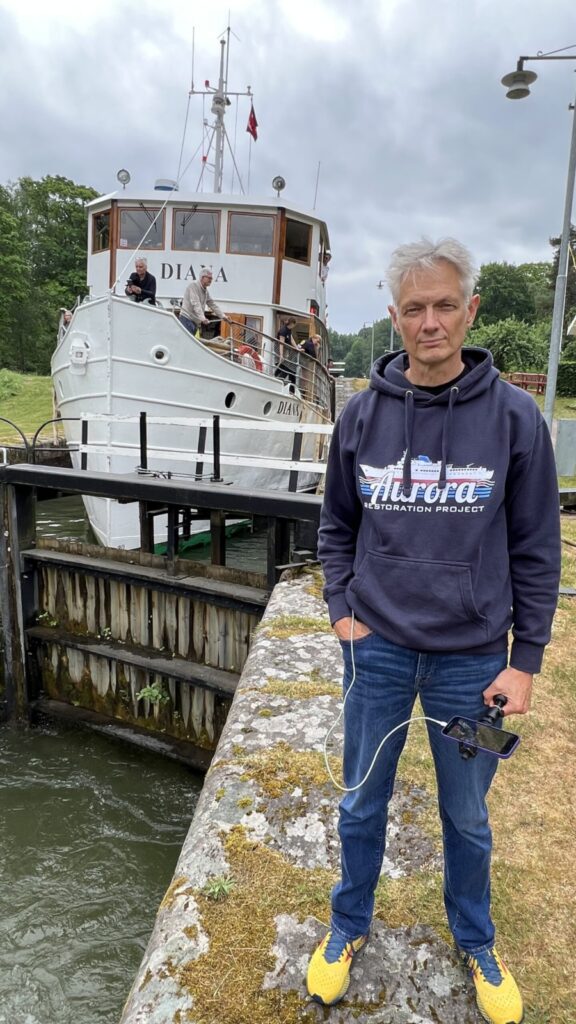
Author Peter Knego and the 50-pax Diana. * Photo: Peter Knego
Barely larger than a giant modern cruise ship’s tender, the handsome, 50-guest, 269-gross-ton MS Diana was built in 1931 and has enjoyed a storied career sailing between Stockholm on Sweden’s Baltic coast to Gothenburg, the country’s main portal on the North Sea.
Traversing a series of lakes, locks and the Gota Canal, itself, Diana’s six-night Grand Sweden voyages are among the most unique and picturesque on this planet.
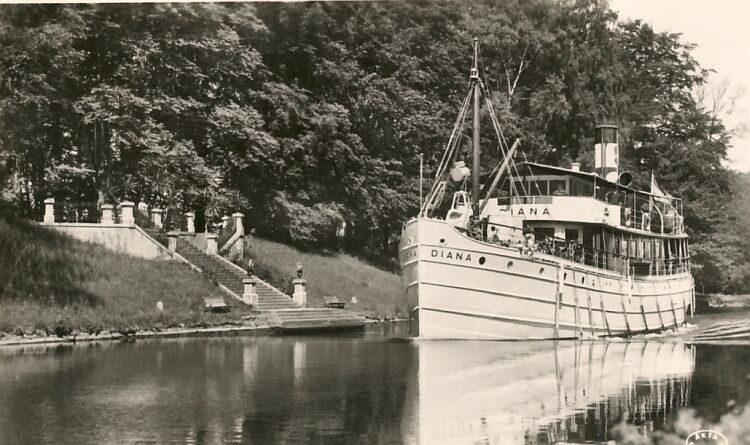
A view of Diana in her original form with a towering foremast before her superstructure was expanded forward. * Photo: Gota Canal Cruises
The Diana, herself, is a diminutive slice of floating history, her quaint looks conjuring up comparisons with the steamer in the movie “Fitzcarraldo” or, perhaps even Agatha Christie’s “Death On The Nile.”
Between her vertical stem and classically proportioned counter stern, her enduringly ribbed and riveted hull supports a sheered and cambered superstructure that consists of two decks with sheltered promenades, topped with a classic stovepipe funnel.
That vertical funnel is actually a relatively new addition, replacing a streamlined early 1960s funnel that never quite looked right, which in turn displaced the original stovepipe funnel from 1931.
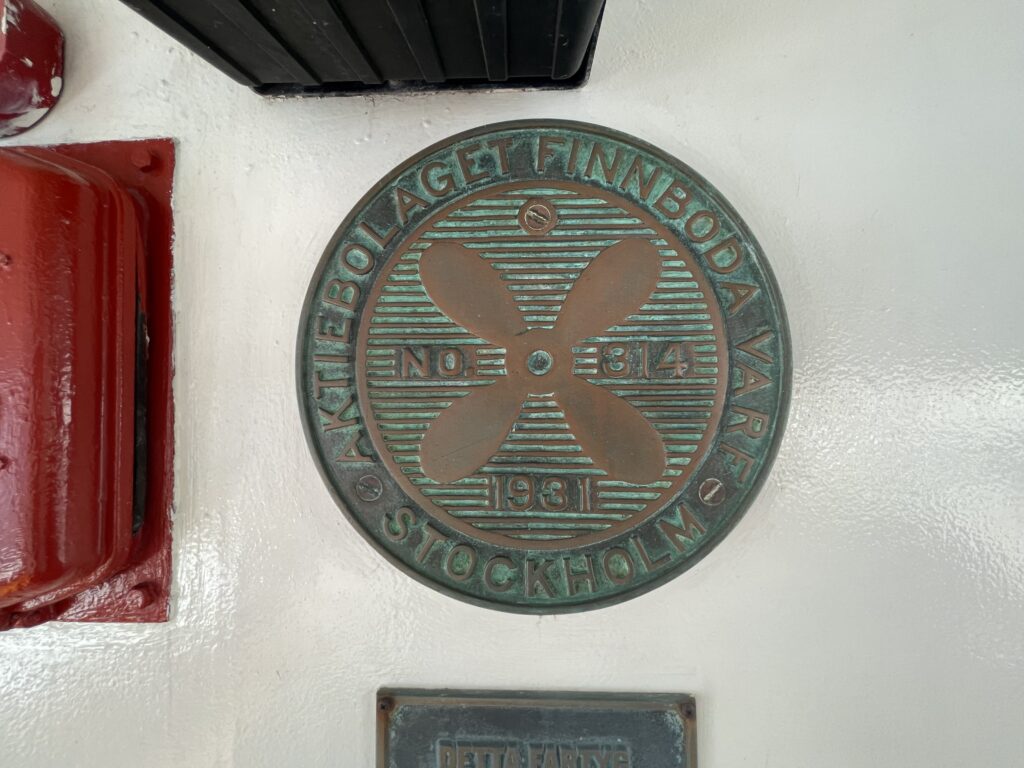
The Diana’s builder’s plate is on Bridge Deck. She was built in 1931 in Stockholm. * Photo: Peter Knego
Initially a steamship, Diana was dieselized in 1969 and given even newer, more environmentally friendly diesels in 2009. In 1987, she sank at her berth in the town of Trollhattan and was declared a total loss but thankfully, her owners raised and refurbished her instead of dispatching her to the scrapyard.
Although technically modernized with the latest in navigation and safety equipment, with her dark wood tones, polished brass and early 20th-century-inspired soft fittings, Diana looks and feels like a classic Edwardian steamer.
VIDEO: Below, enjoy Peter’s video on the fascinating life story of the 92-year-old Diana!
And do subscribe to Peter’s YouTube Channel @MidShipCinema for more of his excellent videos about ships and boats of all kinds.
Subscribe to our monthly small ship cruise email
Subscribe to QuirkyCruise.com for monthly curated newsletters highlighting our top small cruise ship reviews, round-ups & offers!
The Cabins Aboard an MS Diana Cruise on the Gota Canal
Diana has three guest decks, beginning at the top with Bridge Deck, followed by Middle or Shelter Deck and Main Deck which contain three stateroom categories that range from small to even smaller by today’s standards. She also has no lifts and the stairs linking her three decks are more like steep ladders, so she is not a good fit for those with mobility issues.
Other caveats for the totally modern, comfort-seeking cruiser to consider include her not being air conditioned (not normally a problem in her part of the world but the climate is indeed changing and it did get a bit warm in our cabin on a couple nights) and none of her staterooms have a toilet or shower. Further and finally, there are no TVs or WiFi, for that matter.
So, yes, sailing in Diana is truly taking a voyage back in time…
And yet, for those who are seeking a travel experience that is, indeed, quirky, off-the-beaten-track, nostalgic, endlessly scenic and on a refreshingly human scale, a Gota Canal cruise on Diana or one of her sisters, is ideal.
RELATED: Heidi reviews her wonderful trip aboard Gota Canal’s 46-passenger Juno.
I would liken the experience to Hurtigruten’s Norwegian coastal voyages in that the canal boats make numerous brief stops throughout the day, versus lingering for hours in one port while guests go off on excursion.
That said, the inland scenery and quaint towns visited throughout most of the voyage are similar to a European River cruise in that they are seen up close and from a near water level vantage.
Now, back to those staterooms.
On Bridge Deck, there are nine category A’s with narrow upper and lower berths, a wardrobe and a nightstand that opens up into a sink with a mirror.
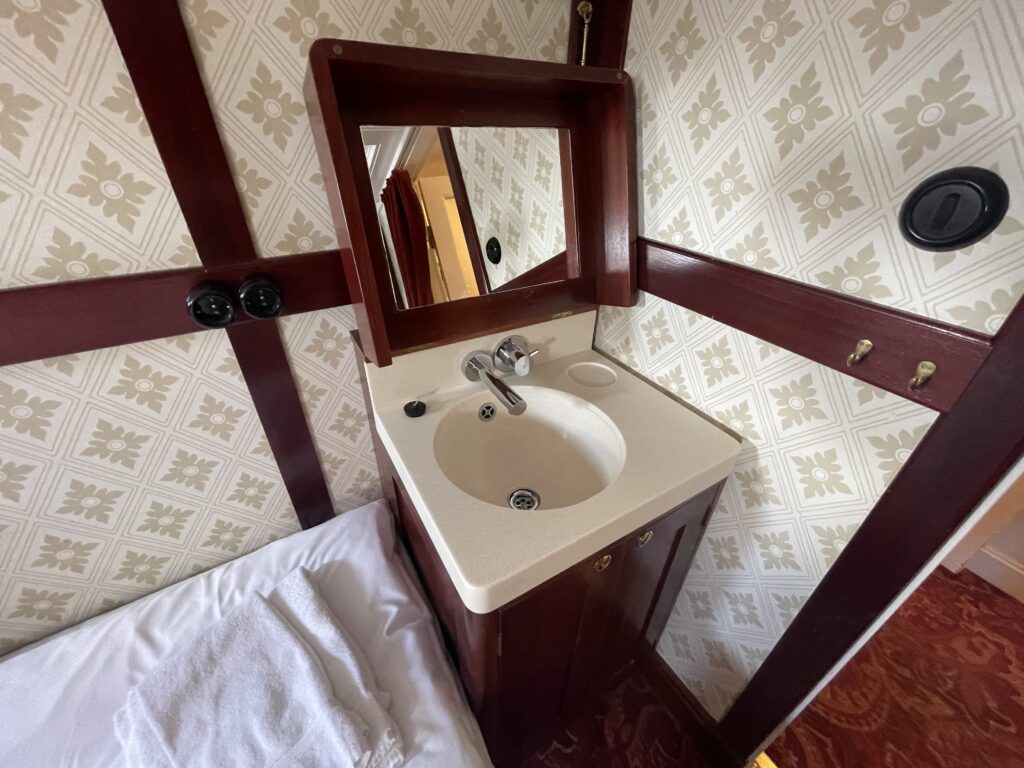
Small nightstands unfold to reveal a sink in each stateroom. * Photo: Peter Knego
Guests in these staterooms are greeted with a tray of chocolates and fresh fruit, as well as a small bottle of bubbly and a robe to use during the cruise.
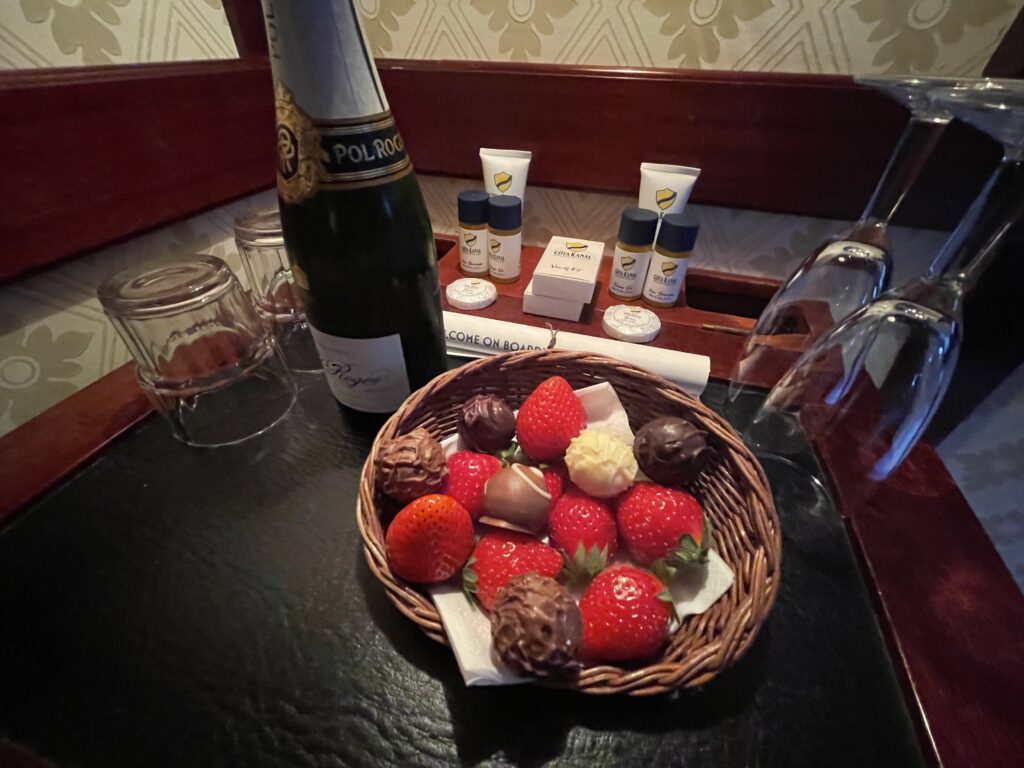
Bridge Deck cabins come with a welcome bottle of bubbly, fresh fruit and chocolates as well as use of a robe for the cruise. * Photo: Peter Knego
On the forward port side of Bridge Deck, Cabin A-23 is a bit larger than the others and might be considered the best on the ship for those who are under 5 feet, 8 inches tall, which is the length of the some of the berths on both Bridge and Shelter Deck, directly below.
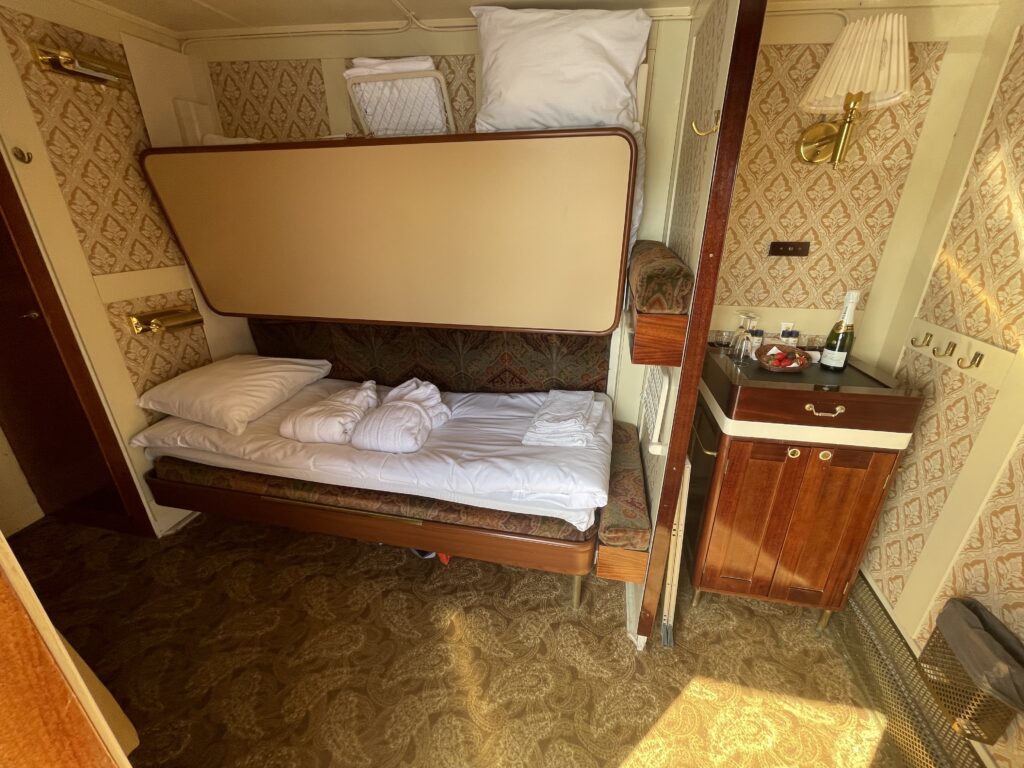
Cabin A-23 is slightly larger than the other upper/lower staterooms on Bridge Deck. * Photo: Peter Knego

A typical Bridge Deck Cabin, which has bunks lined up athwartship. * Photo: Peter Knego
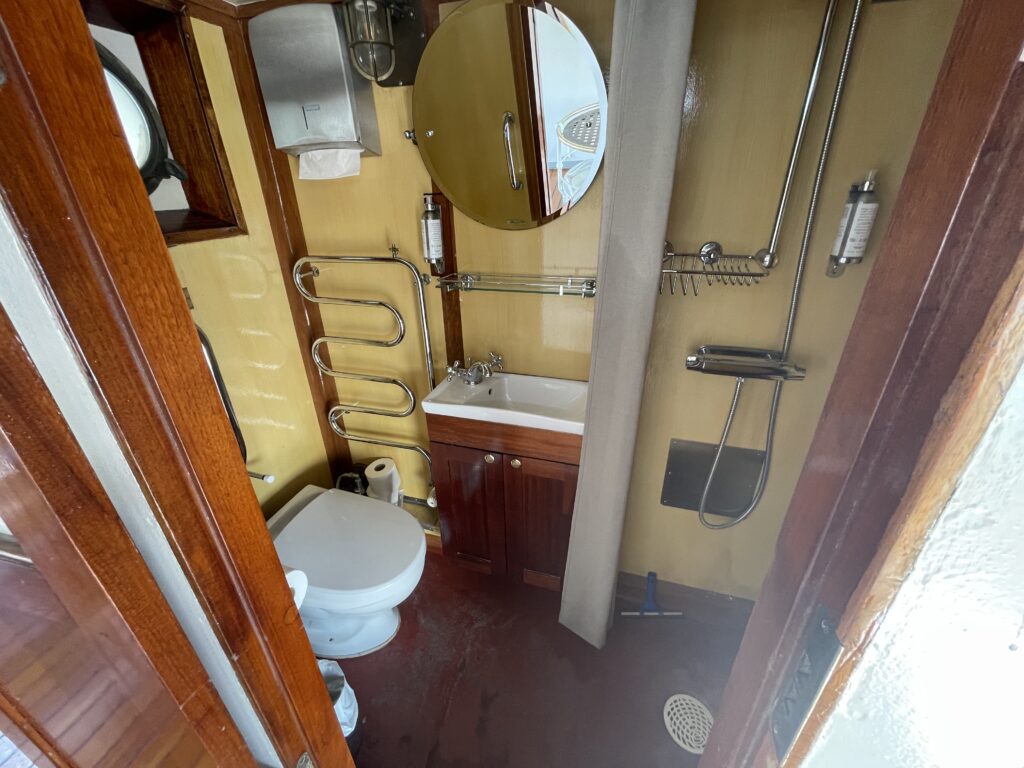
The Bridge Deck bathroom, with toilet and shower. * Photo: Peter Knego
As I mentioned, staterooms do not have private facilities (ie toilet or shower) but public bathrooms are available on each deck and showers are located on Bridge and Main Decks. All are cleaned constantly and in my experience, there was never a wait for either.
Six Category B staterooms located on aft Shelter Deck are even smaller than the Category A’s and would best be likened to train compartments.

A Shelter Deck stateroom can easily be likened to a train compartment. * Photo: Peter Knego
The charm of staterooms on both of the top decks is that they all have picture windows and offer constantly changing views. The downside is that they lack privacy when the doors or curtains are open.
Thirteen Category C staterooms are located on Main Deck and feature two lower beds that are longer than those in the A and B categories, so we opted for one of those as I am almost 6’3” tall.
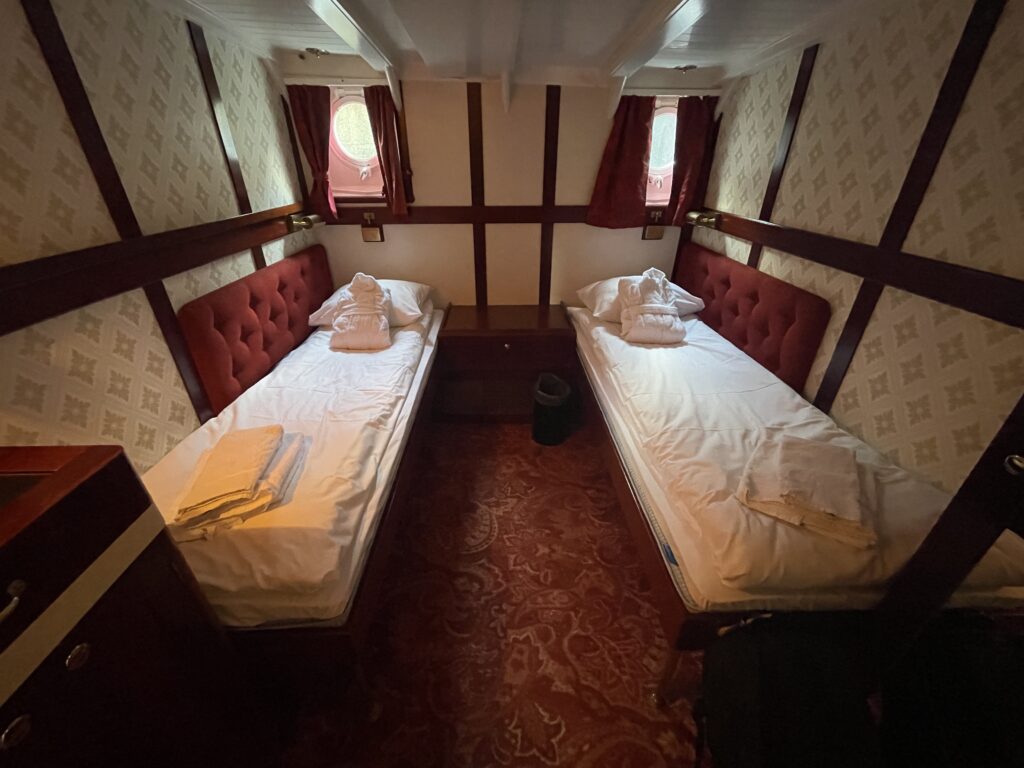
Our Category C cabin, 6, on starboard Main Deck, had two lower beds and a pair of small portholes. * Photo: Peter Knego
These staterooms have a tiny bit more space as well as curtains and doors that close but do not lock. In lieu of windows, they have portholes, which are small but can be opened to allow in fresh air. Ours, Cabin 6 on the starboard side, actually had two portholes.
The Public Areas of the MS Diana
There is basically one large interior lounge on Diana’s Shelter Deck that includes a long dining room that is partitioned into fore and aft sections with a buffet counter aft.
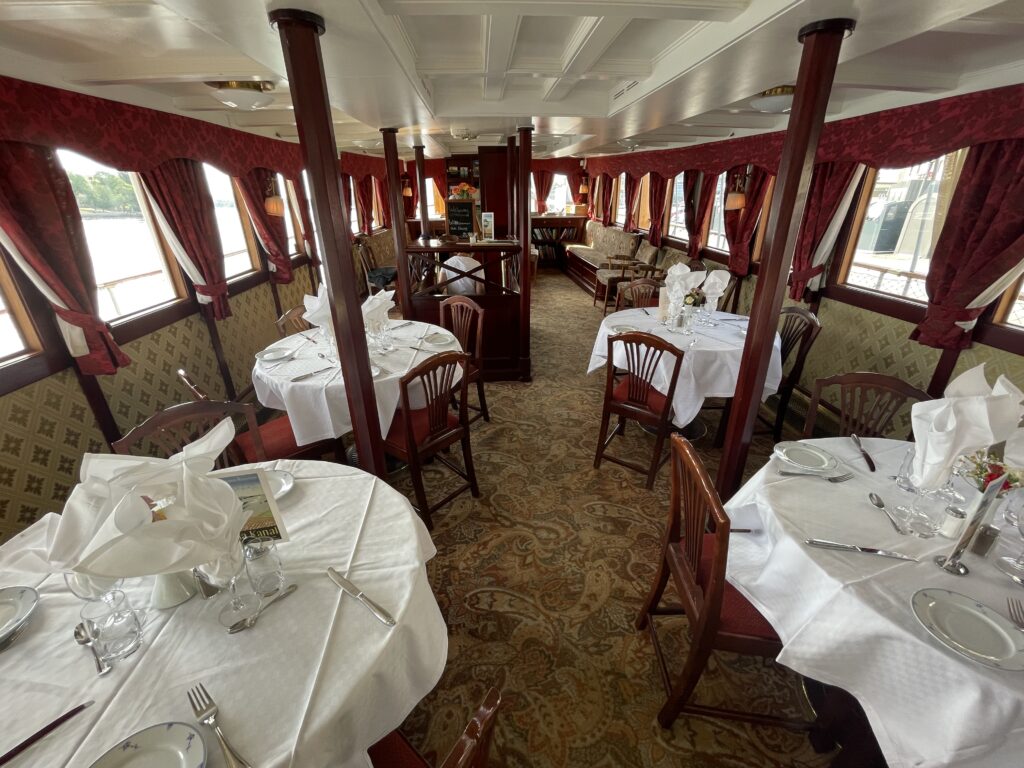
The Diana’s combination lounge and dining room in a forward facing view. * Photo: Peter Knego
The forward section of the room has an area on the port side for cards and board games and a small library with books about the Gota Canal and Sweden on the starboard side.

The forward part of the lounge has a sitting area with games, books and a boutique. * Photo: Peter Knego
There is also a selection of postcards, souvenirs and books guests can purchase.
Aft of the cabins on Bridge Deck, there is a sheltered sitting area with rattan furnishings and a small self service bar called the Honesty Bar, where guests can purchase beer and wine.
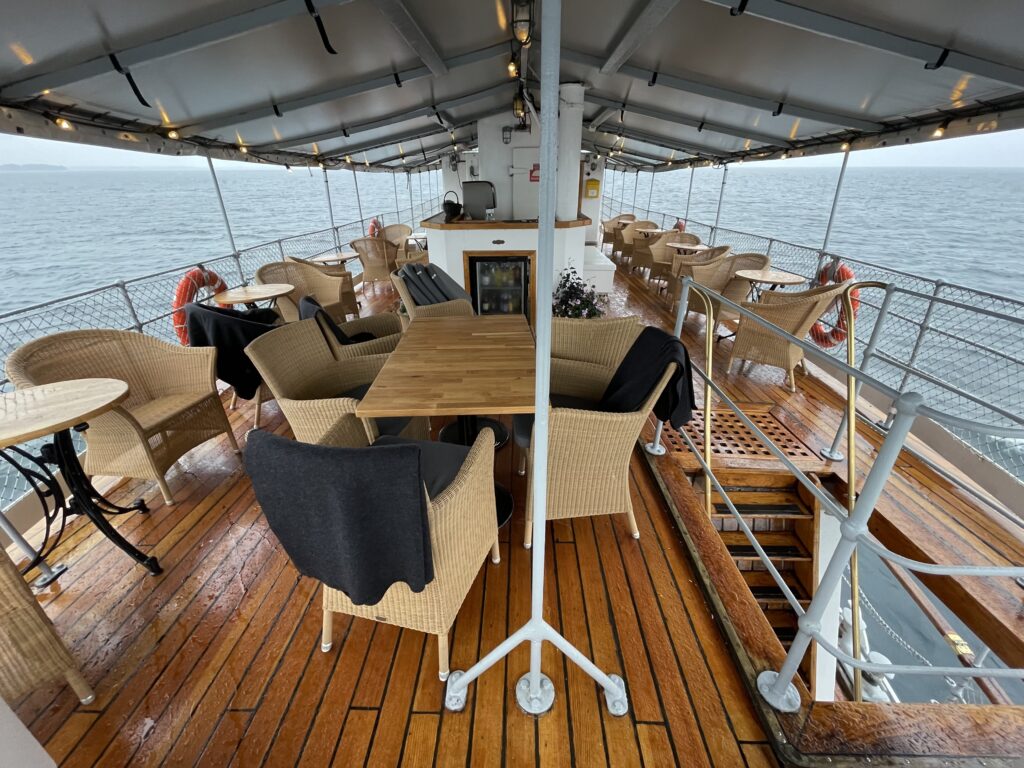
The “Honesty Bar” on aft Bridge Deck (shown later in the cruise). * Photo: Peter Knego
Coffee and tea here is complimentary and this is where the afternoon tea is offered, along with a daily baked pastry or cake.
What To Wear & How To Pack
I would recommend packing as lightly as possible as there is very limited closet space but we managed by keeping things in our unfolded suitcases under the beds. For those with no room under their beds, suitcases can be stored in the hold.
As far as dress is concerned, the Diana would be considered a casual ship with guests in shorts, sweats, skirts and jeans by day and country club casual wear in the evenings.
On the farewell night, we sported coats but many did not and it really didn’t matter.
Our fellow guest mix was German, Swedish and English-speaking and the wonderful guide, Amanda, held port and history talks in each of those languages.

The Six-day Grand Sweden Cruise Itinerary sails between Stockholm and Gothenburg, in both directions. * Map: Gota Canal
Day One: Stockholm to Trosa and Into The Baltic Aboard the MS Diana
At the gangway, members of Diana’s crew welcomed us, whisked our luggage off to our stateroom and suggested we grab a pastry and coffee in the Honesty Bar on Bridge Deck as we prepared to sail.
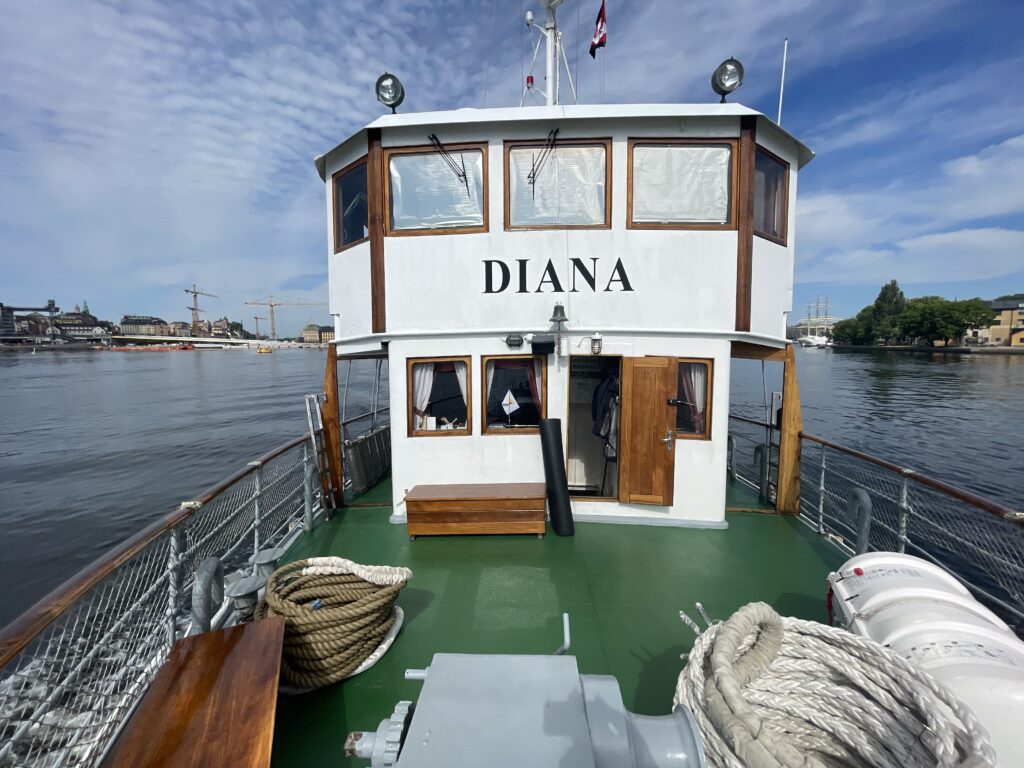
Up on the fo’c’s’le, moments after Diana departed Stockholm at precisely 10:00 AM. * Photo: Peter Knego
Precisely at 10:00 AM, her lines were cast and Diana’s whistle blew before she pivoted into Stockholm harbor and sped off, entering the first lock of the voyage, Hammarby, which would deliver her into Lake Malaren some thirty minutes later.
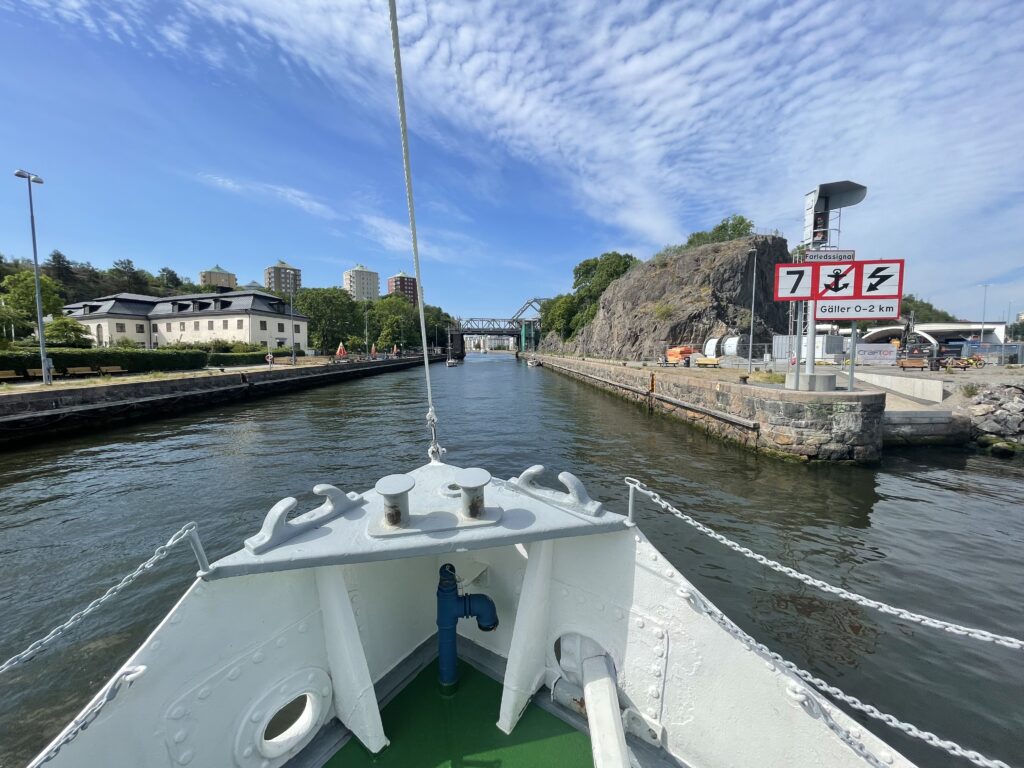
Diana enters Hamarby Lock. * Photo: Peter Knego
After watching the crew maneuver the ship’s winches and lines, hopping from ship to shore and back to the ship like Olympian gymnasts as the lock filled, then opened into the lake, we headed down to our cabin to unpack.
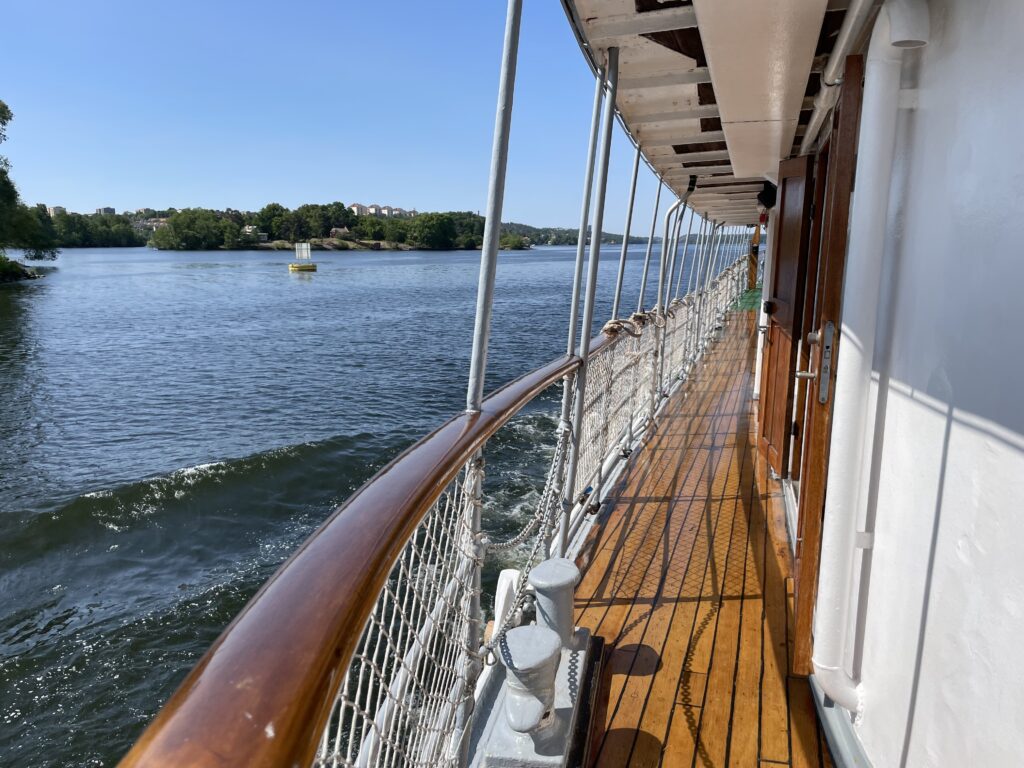
From port Shelter Deck to Lake Malaren on a perfect summer day. * Peter Knego
Later, we found ourselves on the fo’c’s’le, soaking up the “bow breeze” as Diana motored past Stockholm’s suburban sprawl which gradually thinned out until we were surrounded by lush green islands and the tranquil, soothing blue waters of Sweden’s third largest lake.
At approximately 11:30, we heard Diana’s engines slow a bit as she neared the lemon pastel-hued Drottningholm Palace.
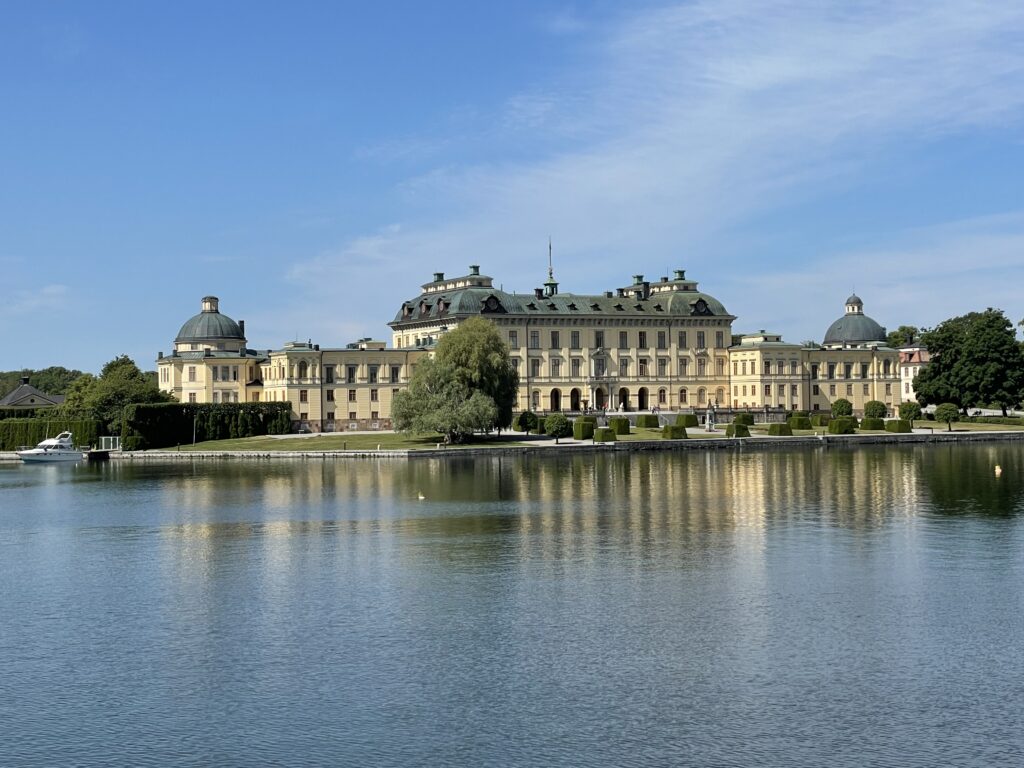
Drottningholm Palace, where Sweden’s king and queen have resided since 1981. * Photo: Peter Knego
Built in the 1600s, it is considered one of the most well preserved royal castles of its era and has, since 1981, been the King and Queen’s residence. Hopefully, the Swedish Royals wouldn’t mind us stopping by for a quick look and maybe a spot of tea before continuing onwards…
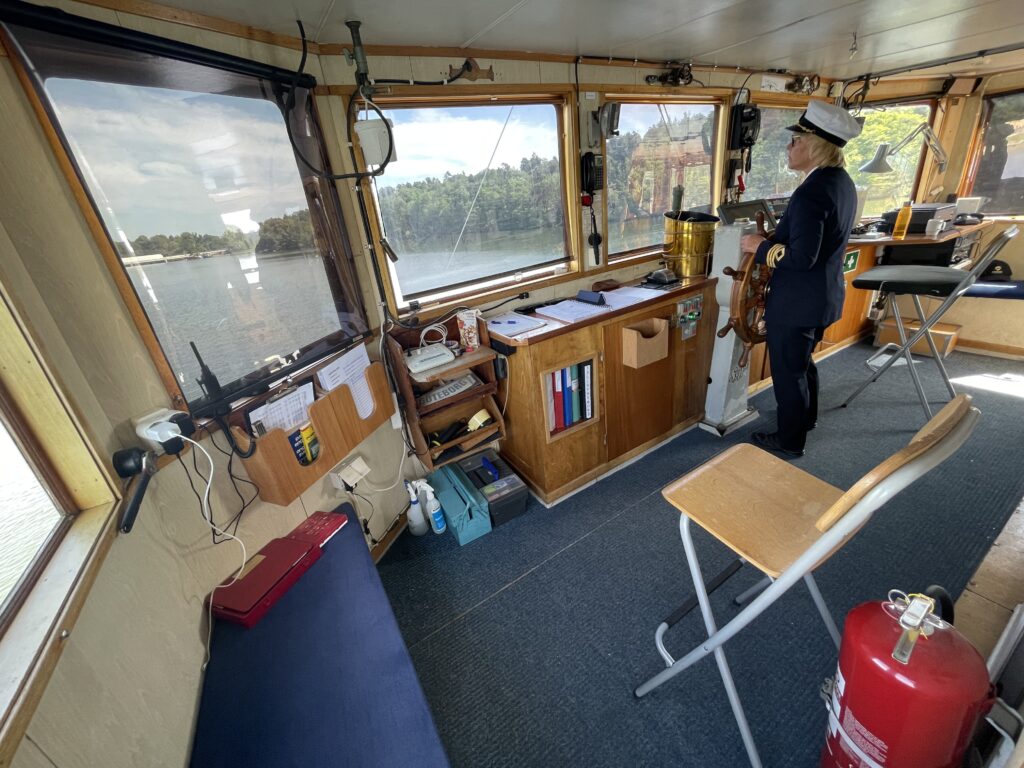
The Gota Canal cruise ships all have an open bridge policy. Diana’s bridge consists of modern equipment that has replaced most of the original navigating gear over the years. * Photo: Peter Knego
I often found myself in the wheelhouse during our voyage, enjoying the Diana’s open bridge policy and the nice views over her bow.
Shortly before lunch, Amanda held the daily talk for the English speaking guests, of whom we were the sole Americans, along with a small group of Brits, Aussies and even a pair of Kiwis (New Zealanders).
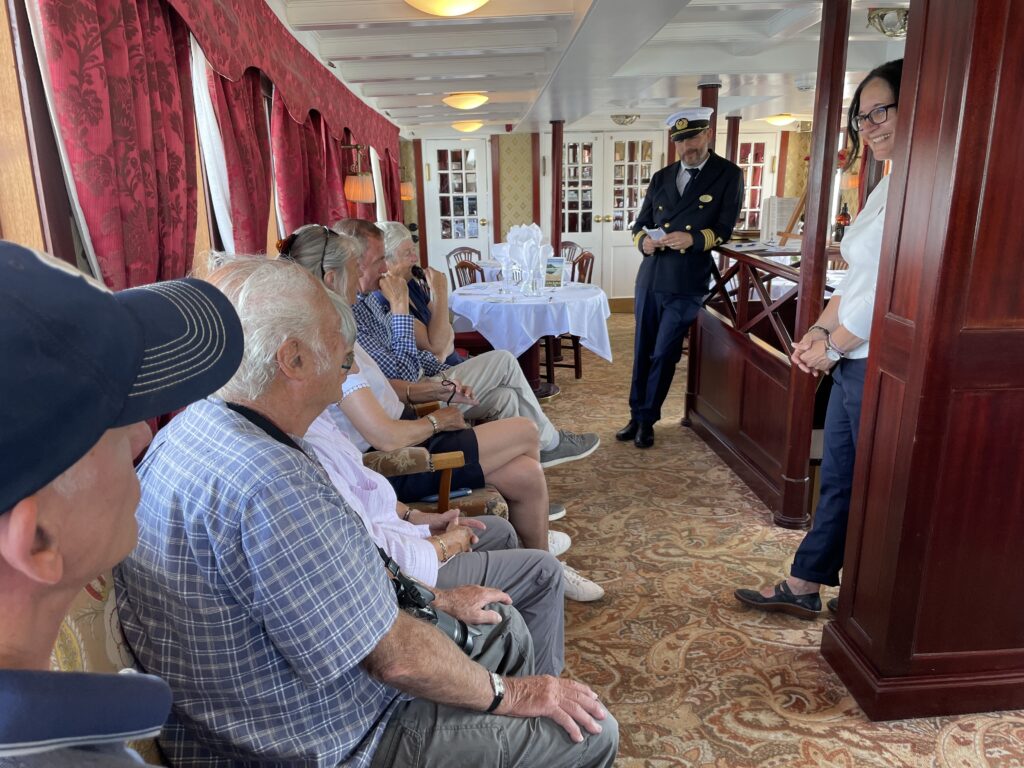
Captain Christopher and Amanda meet with the English-speaking guests in the Lounge. * Photo: Peter Knego
Captain Christopher and members of his crew also went over the basic safety and practical information and again, welcomed us on board.
At the same time, we were assigned a table with a delightful British couple, Russell and Vanessa, who remained our dining companions throughout the voyage.
Every day, usually at 1:00 PM, a two course lunch is served, followed by tea on aft Bridge Deck at 4:00 PM and a three course dinner at 6:00 PM. Unlike lunch and dinner, breakfast is buffet style and open seating.
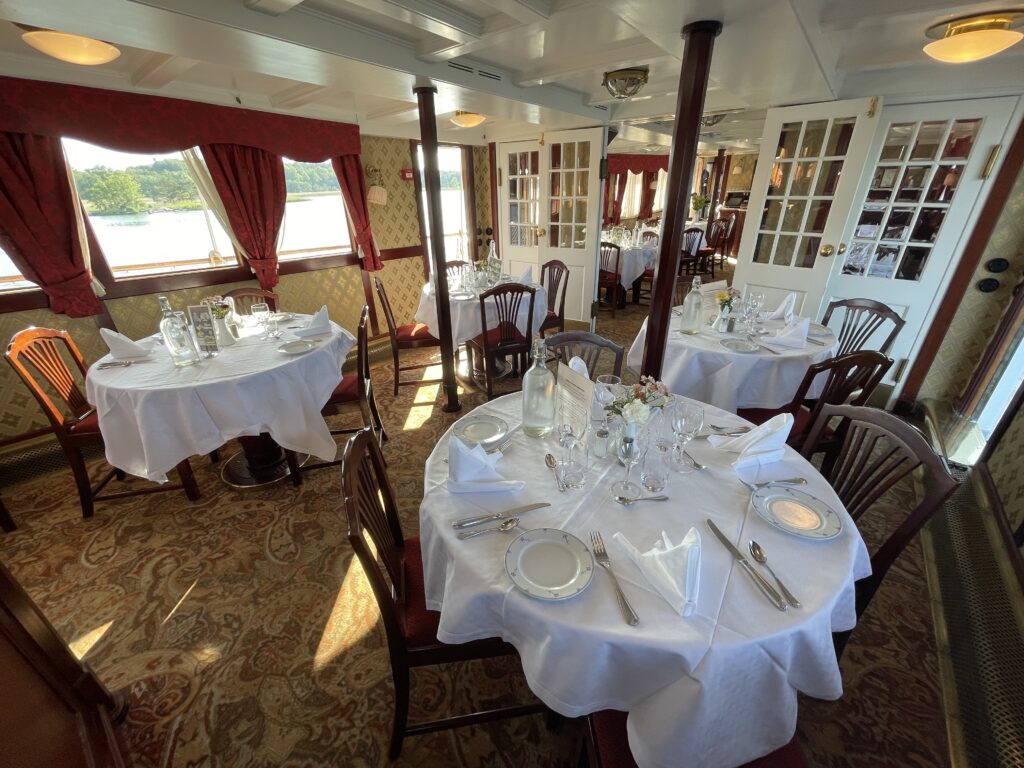
The forward portion of Diana’s dining room, just prior to lunch. * Photo: Peter Knego
I don’t eat meat other than chicken and cooked fish and don’t care for shellfish or uncooked fish — with my strange diet, I often just say that I am vegetarian to make things easier for all concerned. Nonetheless, I gave some advance notice to Gota and was so pleasantly surprised with how efficiently my request was met.
Chef Eva made scintillatingly delicious meat alternatives for me and the wait staff were so charming and discreet when serving them. Much to Gota’s credit, those “just in case” protein bars and peanuts I packed as a back up came home with me after the cruise.
The first lunch consisted of smoked (but cooked) salmon, creamed potato salad and crispy snow peas. Yes, it was basic Scandinavian food but completely homemade with fresh, quality ingredients that made my heart sing.
Dessert was a Swedish Summer Dream consisting of mouth-watering strawberries, lemon curd and whipped cream. Again, it was all very simple but ideal. And don’t get me started on the breads, which were baked fresh everyday.
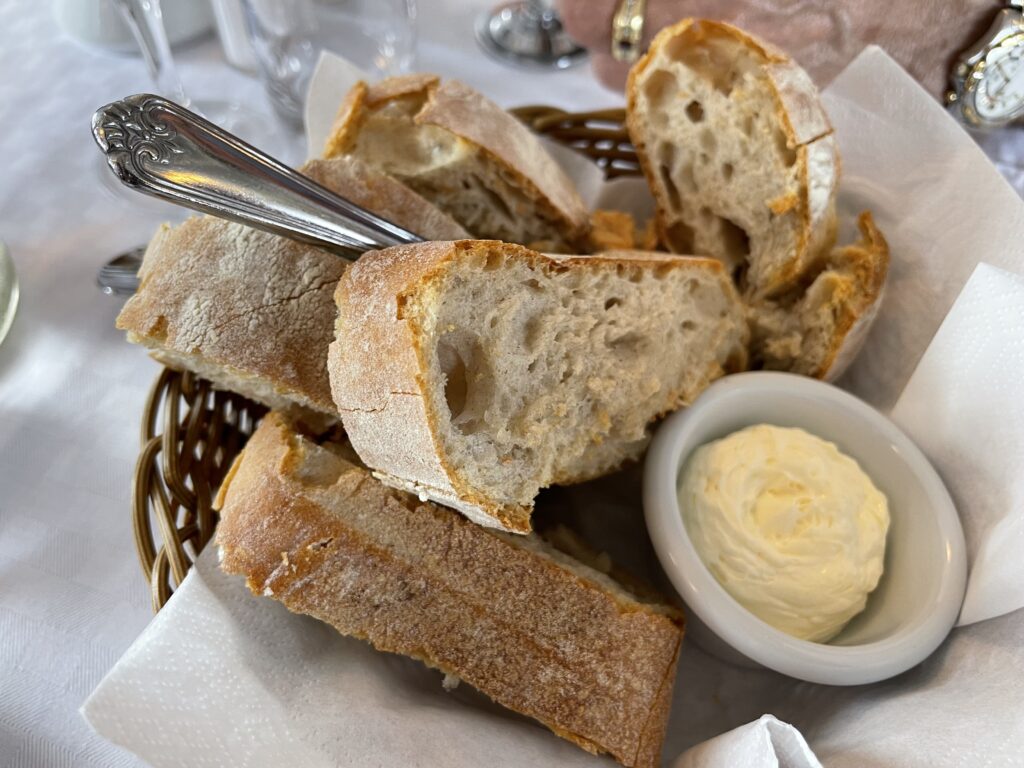
That bread! With every meal, the baked goods were perfection. * Photo: Peter Knego
I’d wager that about four of the six pounds I gained on that cruise were the fault of pastry chef Jacob.
Jacob was also responsible for the outrageously authentic croissants and pains au chocolate that would occasionally show up at breakfast, in addition to a variety of dark and light ryes that were so delicious with the selection of cheeses.
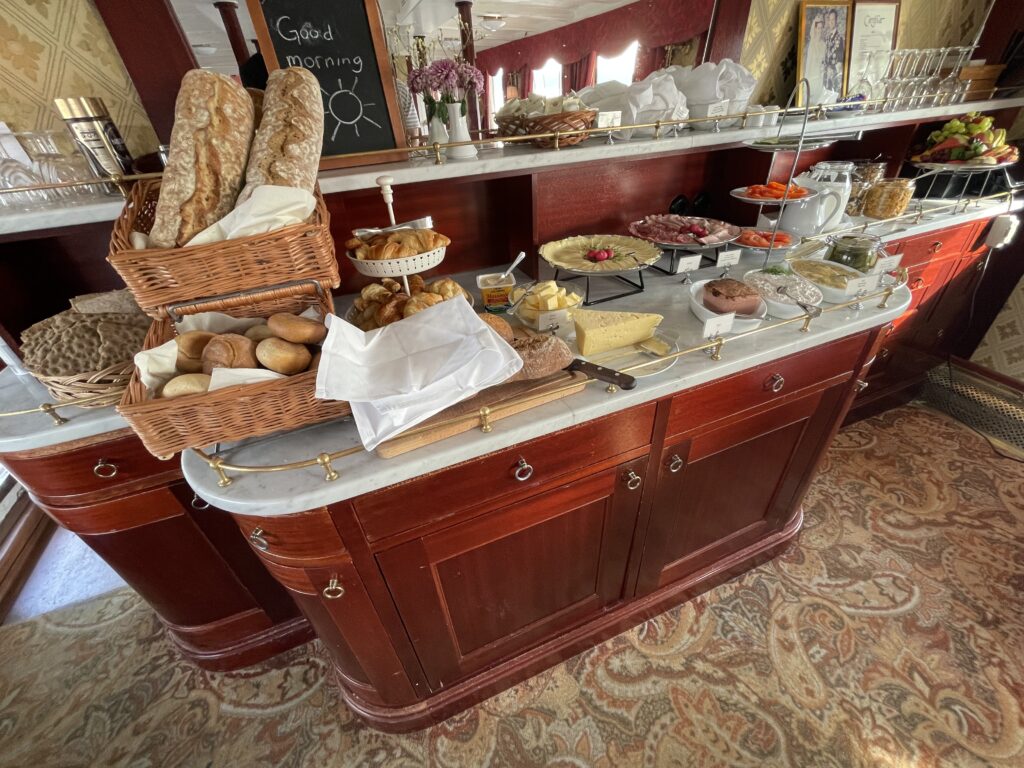
The beautiful breakfast buffet on Diana is replete with all sorts of freshly baked breads and pastries. * Photo: Peter Knego
Every day, there was an egg dish, bacon, muesli, yogurt, cold cuts and surprisingly flavorful melon slices — I mean, do they even grow melons in Sweden?
Shortly after lunch, we were passing from Lake Malaren back into the Baltic via the Sodertalje Locks and sailing through the archipelagoes of Sodermanland and St Anna.
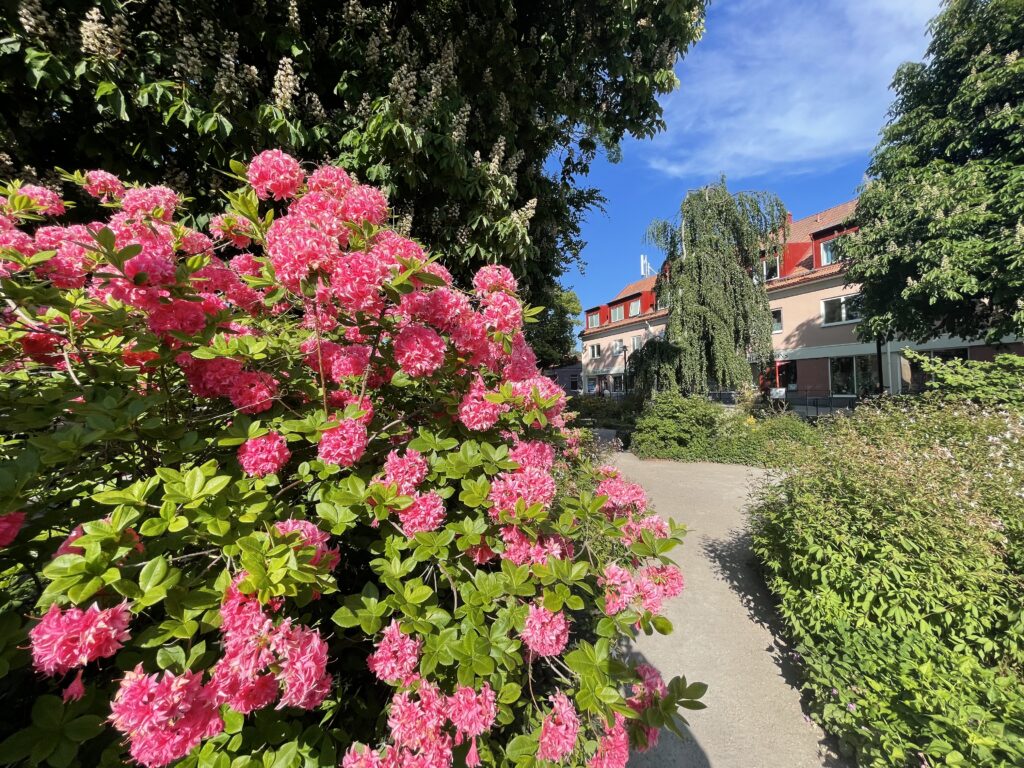
Mingling with the early summer blossoms at our first stop, the resort town of Trosa. * Photo: Peter Knego
Before long, we were pulling up at a marina in the summer resort town of Trosa, which was originally a fishing village founded in the 14th century. We had about 90 minutes to walk along its canal, past wooden houses and brilliant summer blossoms.
At 6:30, as Diana sailed off into the archipelago through mirror-like waters, her long shadow creeping past small islets strewn with red farm houses and sheep, Captain Christopher welcomed us with some bubbly and a “Skoal!” on aft Bridge Deck.
After an excellent first dinner (carrot soup, chicken with cheese gratin and rhubarb compote with almond crumble), we ogled the passing scenery in the increasingly golden light.
We were actually just days away from summer solstice and the sun was not setting until around 10:30 PM, which was shortly after we retired that evening.
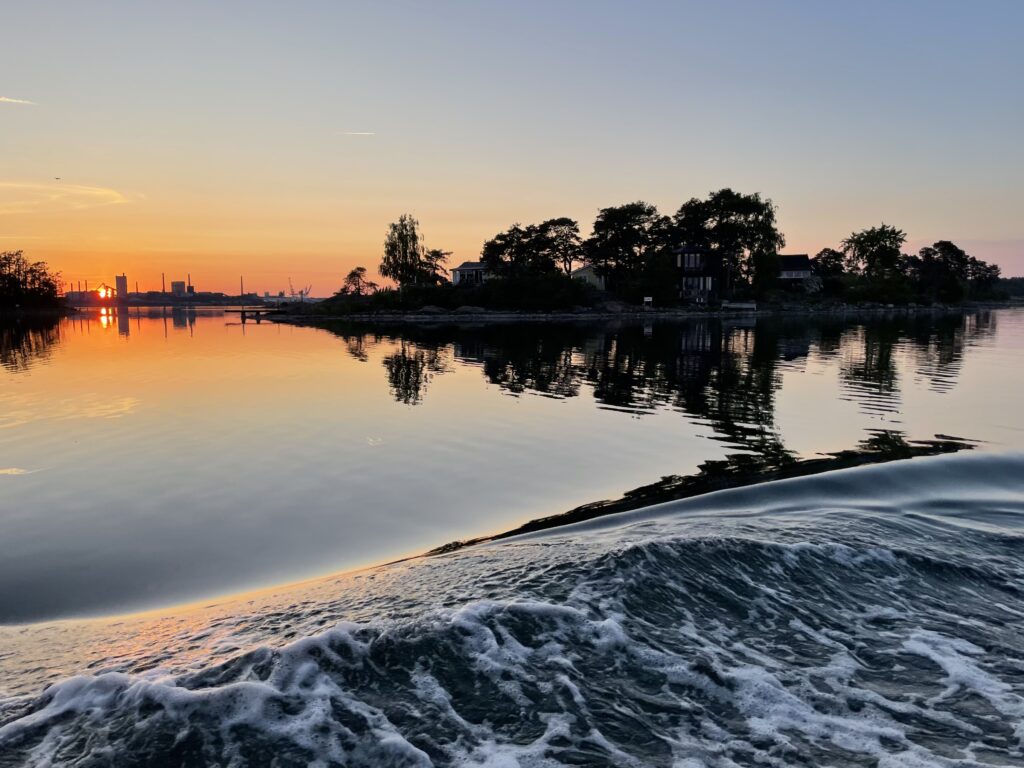
10:30 PM summer night sunset from Diana’s cabin 6. * Photo: Peter Knego
Day Two: Stegeborg to Norsholm By Default
In the early morning darkness, Diana tied up at the tiny port of Stegeborg. We were up extra early and used that opportunity take a three-mile run through the pastoral green countryside, past more of those red barns and sprawling estates.

The stone turret of the crumbling Stegeborg Fortress captured during our morning run. * Photo: Peter Knego
We returned to the ship just in time for a guided tour of the ruins of the Stegeborg Fortress, which dates from the early Middle Ages. Margarethe, the local guide, spoke perfect English and had a wonderfully low key sense of humor that I would pick up on a beat or two later.
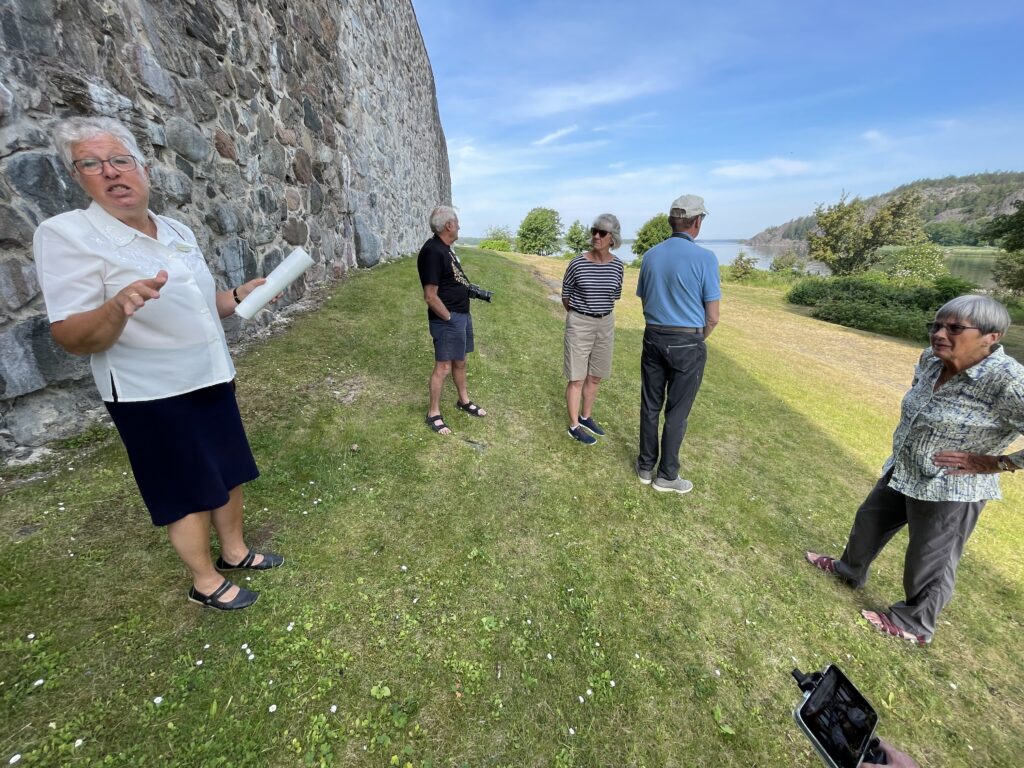
The delightful Margarethe shows us around the grounds of the Stegeborg Fortress. * Photo: Peter Knego
An hour after we sailed, we were approaching Mem and the first of the 58 Gota Canal locks, although it was the last one to be completed in 1832.
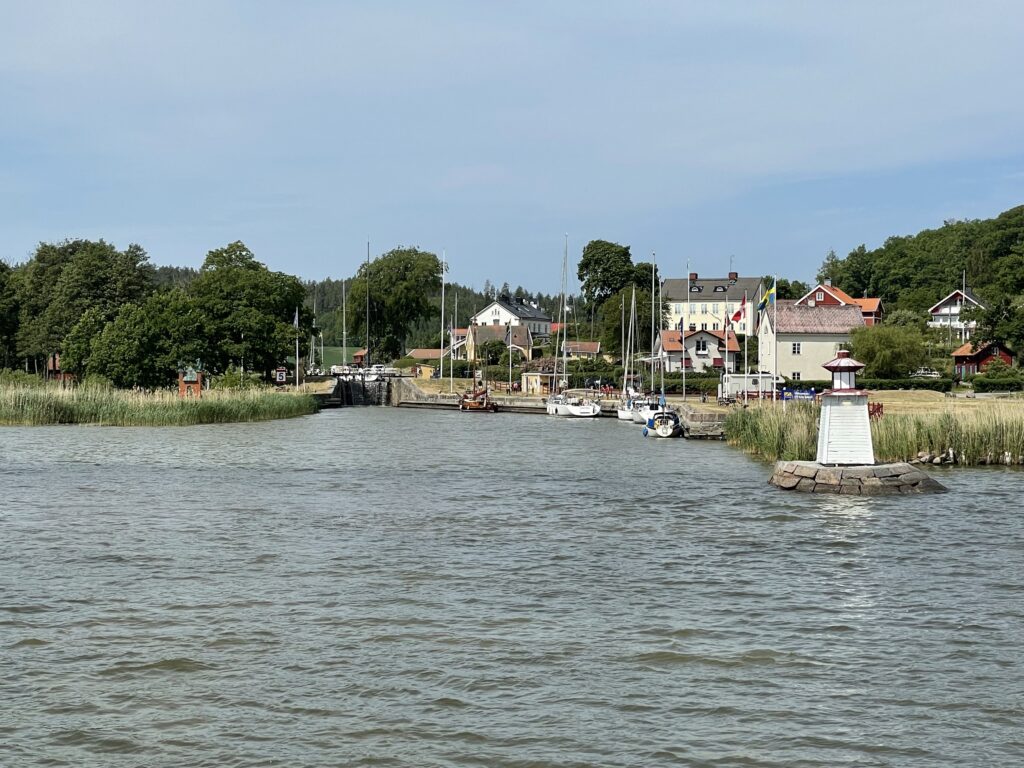
Although chronologically the last, Mem was the first Gota Canal lock we encountered on our westbound voyage. * Photo: Peter Knego
The Gota Canal, itself, is 120 miles long, 54 of which were dug or blasted out to connect Gothenburg with Stockholm via numerous lakes and other natural waterways.
Conceived in the early 16th century, it was not actually realized until 1810 when the Swedish government appropriated funding for what was the largest infrastructure project in the nation’s history, employing 58,000 workers over a 22 year period.
It was Scottish engineer Thomas Telford who came up with the initial plans after having designed the Caledonia Canal in Scotland.

Sealed in our first lock chamber at Mem, before being lifted to the next level. * Photo: Peter Knego
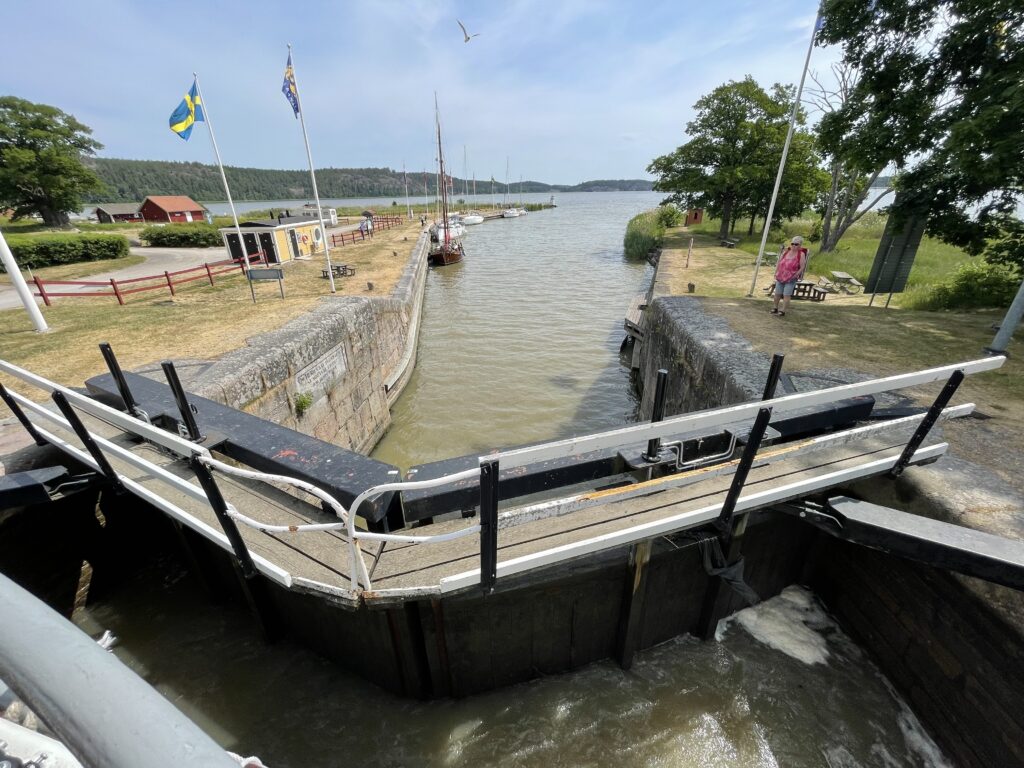
After the chamber is flooded, Diana gains a new perspective on her surroundings and then proceeds into the next chamber to do it all over again. * Photo: Peter Knego
For many years, the Gota Canal was an essential transport system for passengers and cargo but these days it is mainly used for recreational purposes.
With its highest point being 301 feet above sea level, it’s 58 locks can accommodate vessels up to 98 feet long, 23 feet wide and up to 9.2 feet in draft, which is pretty much the Diana and her two sisters’ dimensions.
As we would discover throughout the journey, people who clearly knew the canal boat schedule were lining the banks on either side, greeting the Diana with phones and good old fashioned cameras.
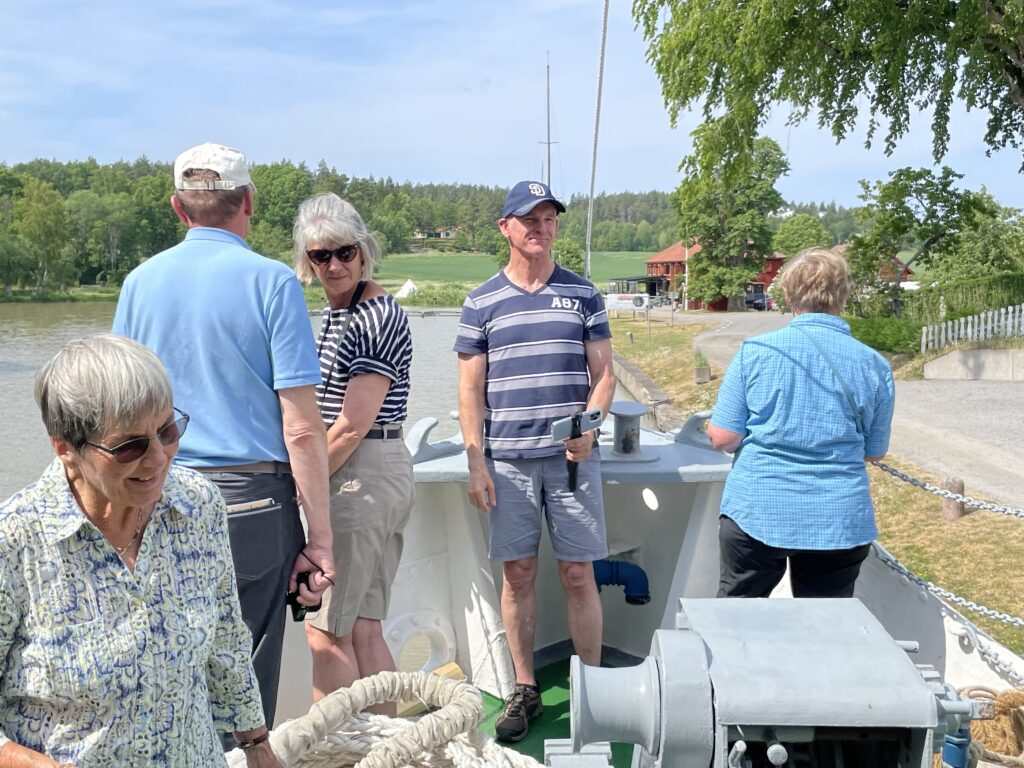
All guest hands were on deck to bear witness as Diana began her official transit of the Gota Canal. * Photo: Peter Knego
Of course, our first Gota Canal lock was a major event on board and all guests were poised along the open promenades, on the fo’c’s’le and at the stern, watching as the gates closed behind us and the water gradually gushed in.
Once the chamber filled, Diana was elevated enough for the forward gates to be safely opened and sail onward.
After lunch, we were nearing Soderkoping, a town dating from Medieval times that is renowned for its Swedish ice cream, old houses, town hall and two Medieval churches.

The angular medieval structures of the St. Laurentii Church and bell tower at Soderkoping. * Photo: Peter Knego
Suffice it to say, our first stop was an ice cream stand for a pair of double scoop cones, their sugar-drenched flavors rapidly melting in the summer heat as we walked through town, then climbed a zigzagging wooden staircase some 350 steps up to an overgrown scenic outlook and finally, once back down, there was just enough time to visit the St. Laurentii Church (which dates from the late 13th century).
Back at the Diana, we joined fellow guests who followed the ship on foot as she slowly motored past a draw bridge and a total of eight more locks.
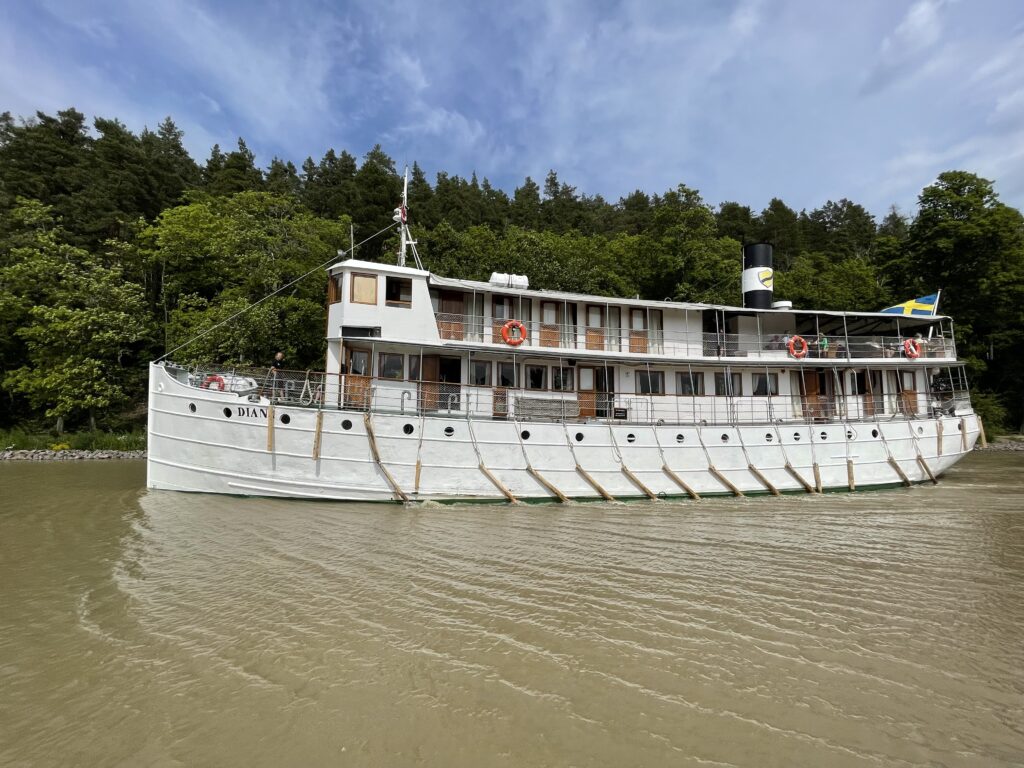
Following Diana along the canal near Soderkoping. * Photo: Peter Knego
This gave us some wonderful photo ops of the classic vessel in transit, her wooden bumpers dragging at a diagonal which, in our wild imaginations, conjured up the oars of an old Roman slave galley or perhaps a Viking longship.
After re boarding at the Carlsborg Lock, we gazed on as Diana navigated a winding cut with vast farmlands and forests on either side, and then, during dinner, there was an announcement that would change the outcome of our evening…
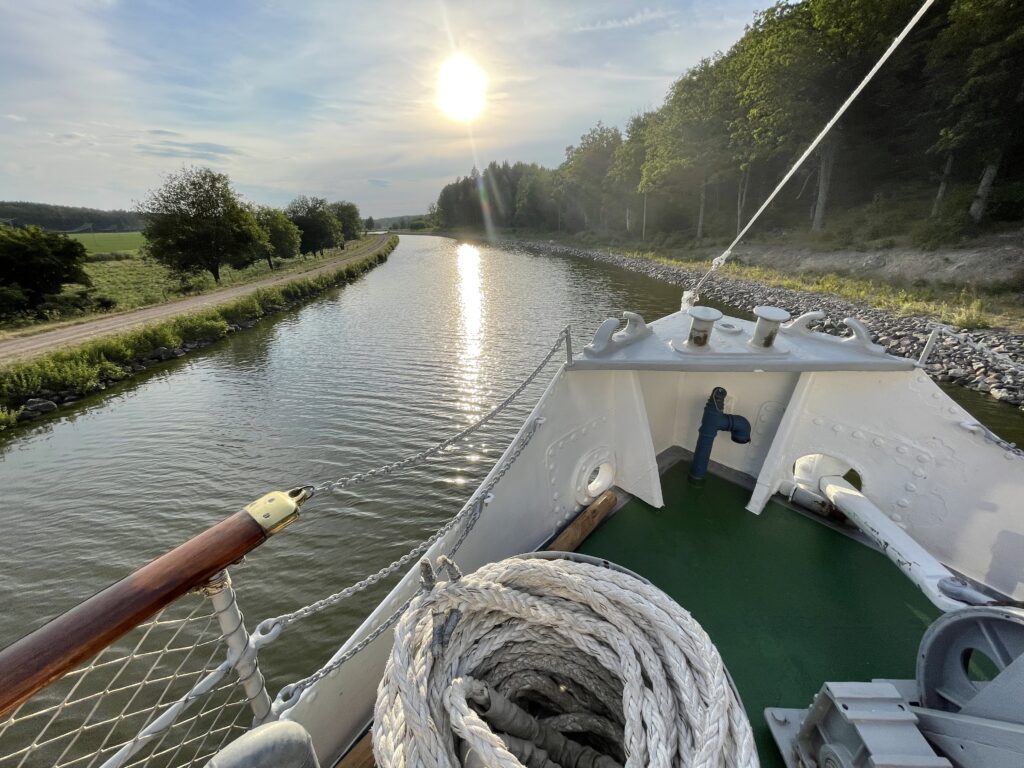
Winding through the Swedish countryside aboard Diana. * Photo: Peter Knego
The pump for Diana’s toilet system seized up and we would have to get a backup from the Diana’s 1912-built sister ship, the Wilhelm Tham, which was heading eastbound several hours away by car. Diana would thus have to pull alongside a campground near the town of Norsholm for the night, close to a facility with toilets that we could use.
My 3:00 AM wake up calls would take on a new twist…
And so goes the adventure aspect of quirky cruising on a classic ship like the Diana. Everyone on board thankfully took the news in stride as the good natured crew worked tirelessly into the night getting that spare pump installed.
Day Three: Cruising From Norsholm To Motala With Relief
The following morning, all who had not already encountered the “Toilets are working!” sign at the gangway were pleased to hear the announcement that the Wilhelm Tham’s spare pump had done the trick and Diana’s plumbing was back to snuff. We departed at precisely 7:00 AM, behind schedule but determined to make up for lost time when we encountered our next obstacle.
As the doors of the next lock shut behind us, the railway draw bridge in front of us refused to budge upward. There was a problem with the wiring that took another hour or so to fix, eventually allowing the bridge to raise and Diana to move forward. Had the operators not fixed that bridge, I’m not sure what would have happened…
From there, we motored across the relatively small Lake Roxen, which is about 108 feet above sea level. Our planned excursion to the town of Vreta and its church and convent had to be cancelled due to our late arrival.
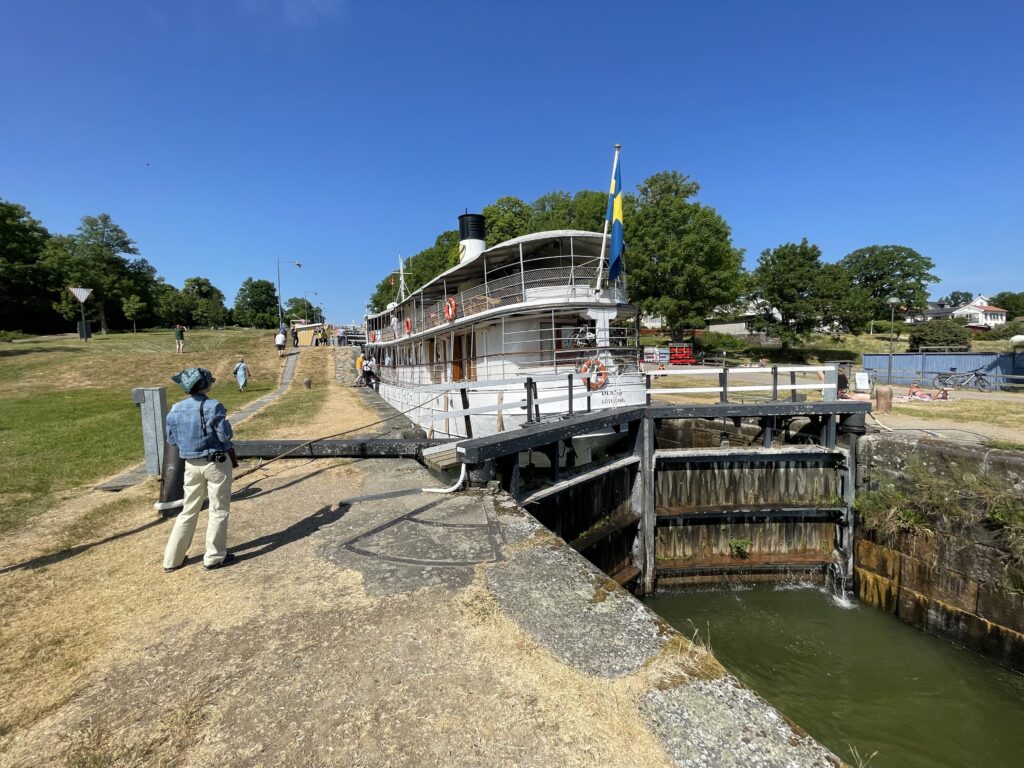
Diana in lock two of seven on her way “up” at Berg. * Photo: Peter Knego

Diana near the top of the Carl Johan lock “staircase” at Berg. * Photo: Peter Knego
An hour or so later, Diana had arrived at the Carl Johan locks in Berg, which consists of a “staircase” of seven locks that raise the ship another 61 feet above sea level.
Once again, there were quite a few spectators on either side of the lock to capture our ship “climbing” upwards.
From there, we transited across a long waterway, including two “aqueducts” where the canal itself was supported by a bridge that crossed over two highways.
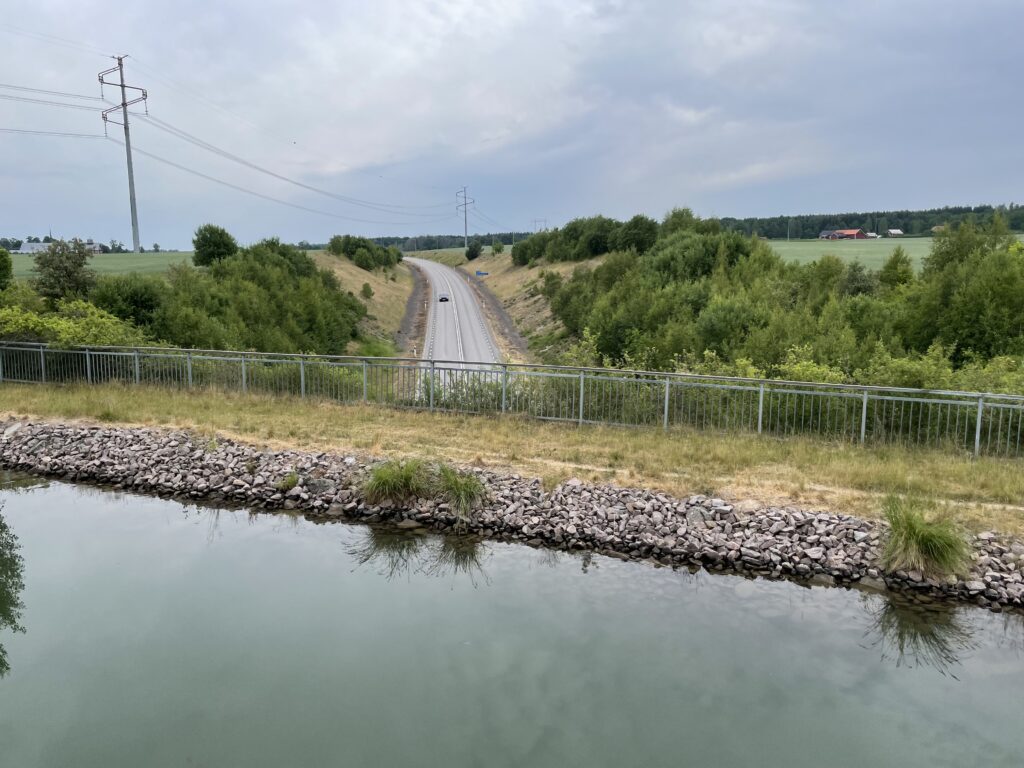
Crossing over a highway via one of two Gota Canal “aqueducts.” * Photo: Peter Knego
At lunch, we were offered a choice of various aquavits (that strong Nordic liquor that is often called schnapps) to toast with as the crew serenaded us in Swedish. I’m not sure how much I fancy aquavit but it was a very sweet gesture on the part of our tireless crew, many of whom did not get any sleep the night prior, thanks to the faulty pump.
That afternoon, I had begun reading the novel “Roseanna” by wife and husband authors Sjowall and Wahloo, which features the MS Diana as the setting for a gruesome murder.
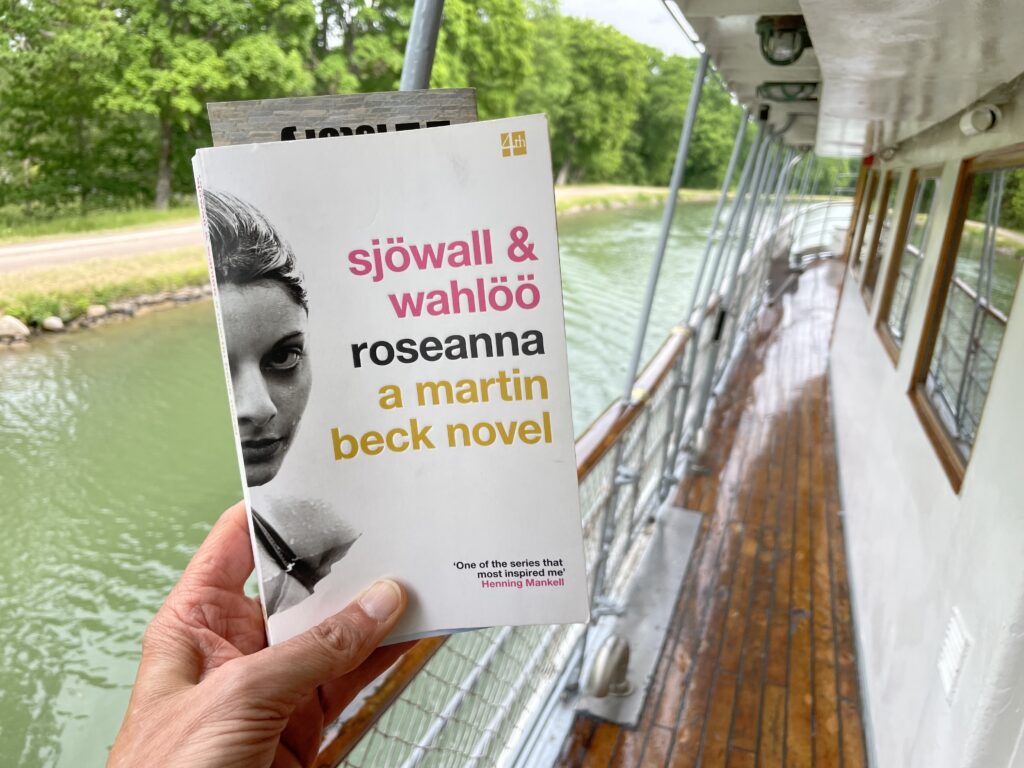
“Roseanna” aboard Diana. * Photo: Peter Knego
Not a voracious fiction reader, I borrowed the book from the library and planned to skim through it but immediately found myself hooked. It turns out “Roseanna” is actually a very well known book in Sweden and as the first of 10 Martin Beck detective stories, has been made into a popular British TV movie, as well.
The story of an American girl who is brutally raped and murdered in her tiny cabin (A-1) on aft Shelter Deck, then dumped into the canal, was actually inspired by a cruise in which the authors encountered an attractive American girl on board, much to the pleasant distraction of Wahloo and annoyance of Sjowall.
Our host Amanda shared that the book was Sjowall’s way of dealing with Wahloo’s “distraction” in a purely imaginative way. Sjowall was actually a regular guest on board Diana until she passed a few years ago.
Later that afternoon, as the clouds rolled in for the first time on our journey, we arrived at the Borensberg lock, which is one of two that are actually hand cranked, providing their lock operator and members of Diana’s crew with a little extra exercise in the process.
From there, it was across Lake Boren, another relatively small lake, where at dinner time, we encountered our eastbound fleetmate Wilhelm Tham as she exited the Borenshult Locks, which consists of a staircase of five locks and is coincidentally where the fictional body of Roseanna was discovered in that book I was now so engrossed in.
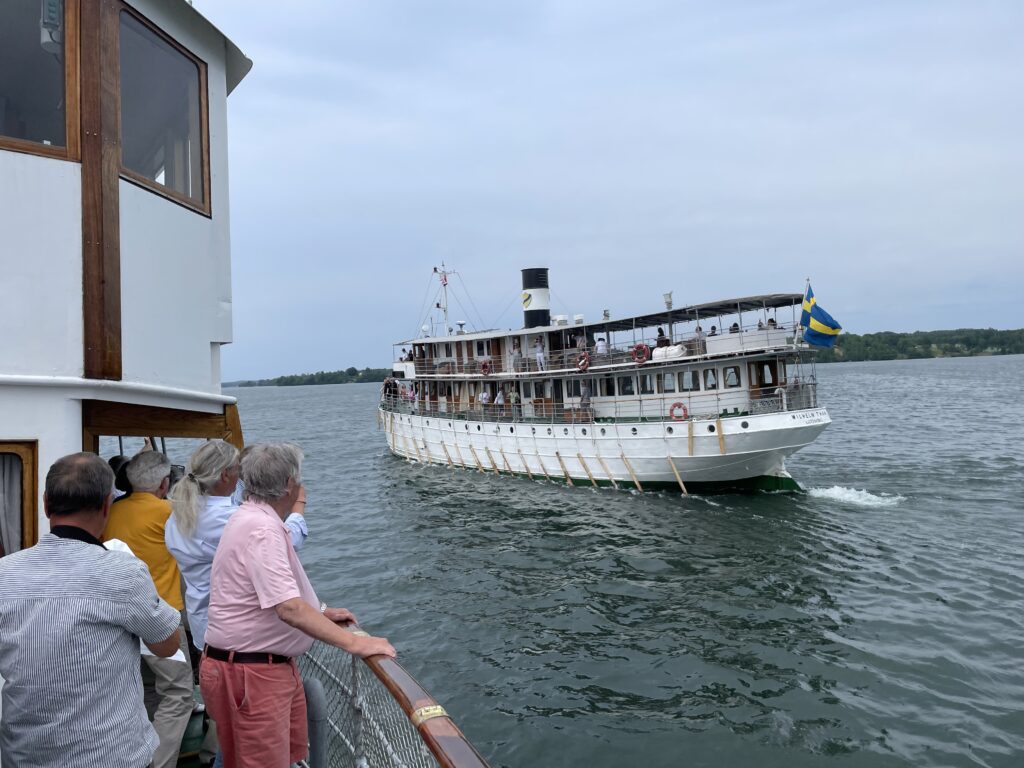
Diana and 1912-built fleet mate Wilhelm Tham meet outside of the Borenshult Locks on Lake Boren. * Photo: Peter Knego
With our combined speed and diminutive size, our encounter passed all too quickly as the two classic former steamers saluted each other, guests lining their rails. Meanwhile, for a short few moments, our dinners had been abandoned.
We arrived at Motala, our stop for the night, well after dinner was finished but the day was not yet over.

Reflections of Diana at Motala. * Photo: Peter Knego
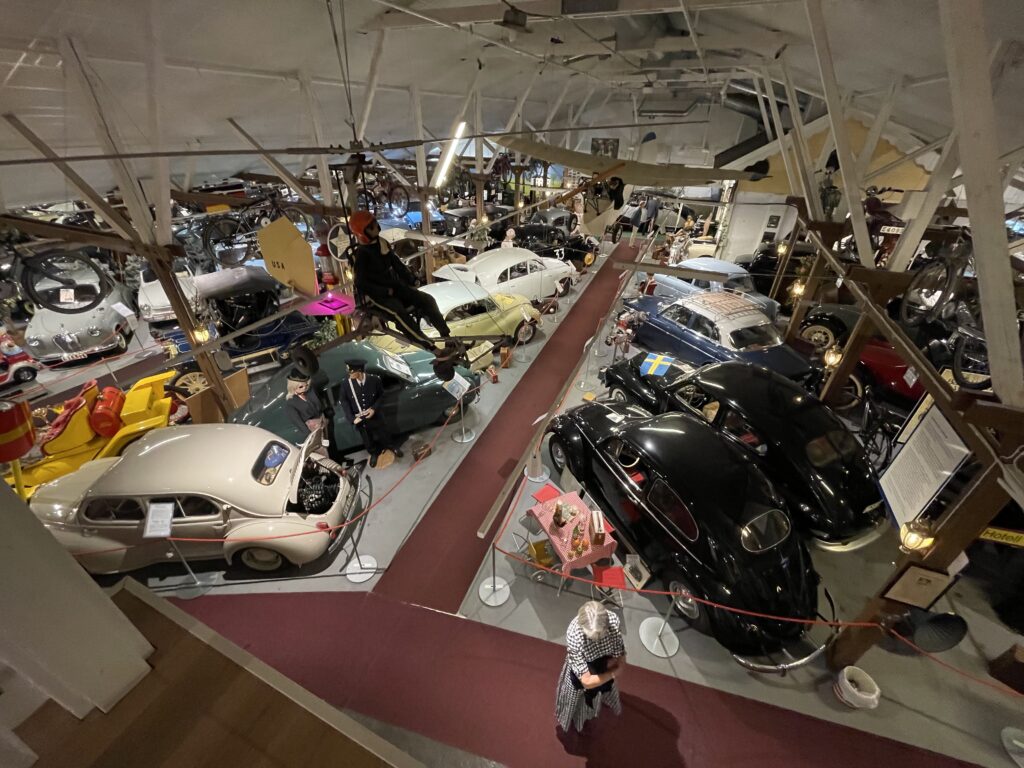
A small part of the luxury car selection of the vast Motala Motor Museum. * Photo: Peter Knego
Across from where we were berthed was Motala’s Motor Museum, where, despite the late hour, we were given free access to its vast and eclectic collection of classic cars, toys and motor-powered objects.
Day Four: From Motala to Hajstorp In The Rain
On Day Four, we awoke particularly early and started getting into our running gear just as a downpour began. Oh well, we would surely live to exercise another day…
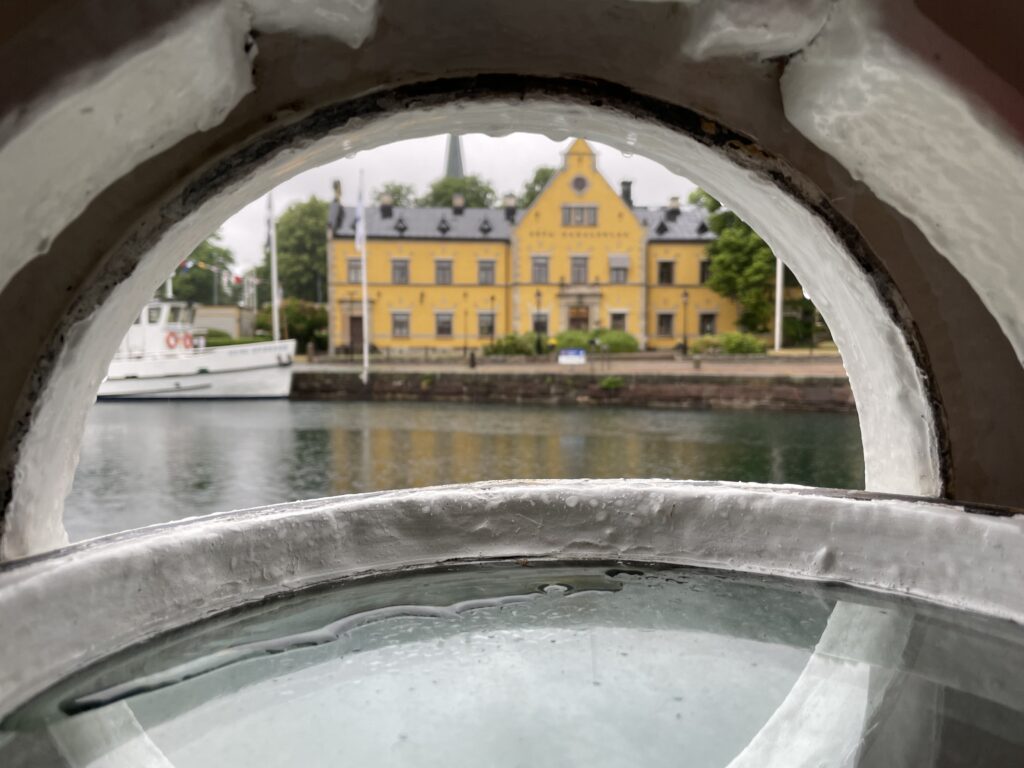
A rainy morning in Motala. * Photo: Peter Knego
At 07:30, our MV Diana cruise on the Gota Canal departed Motala and entered Lake Vattern, Sweden’s second largest, which was akin to being on an inland sea, especially with the strong winds and rain that morning.
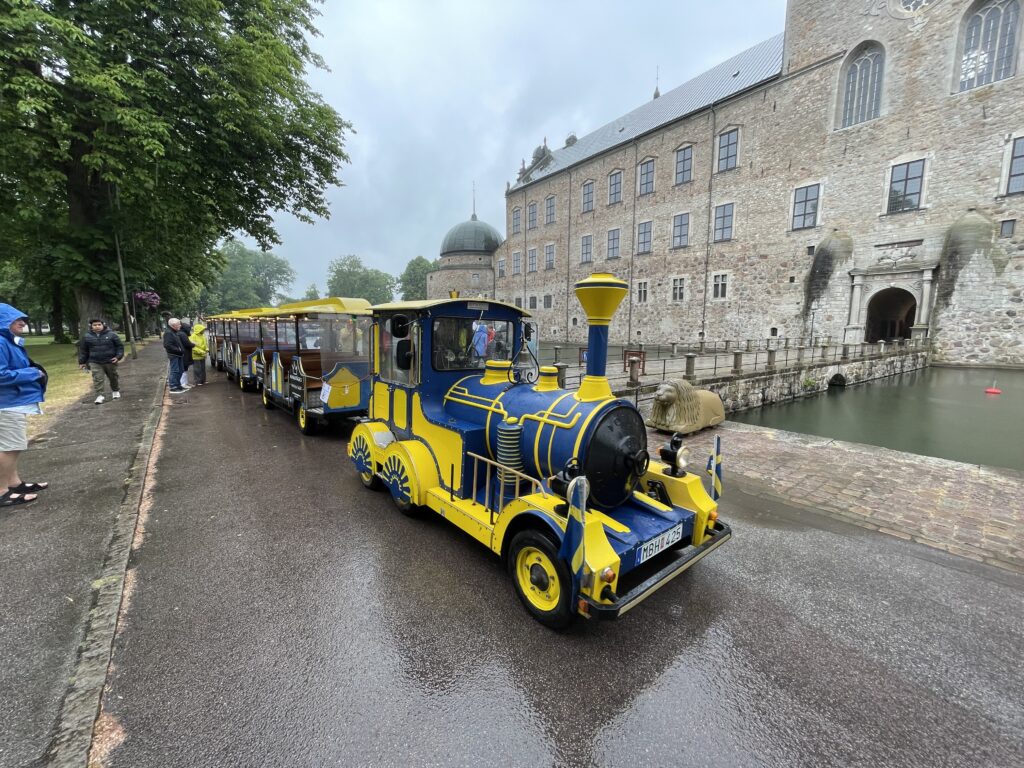
Vadstena’s trolley awaits. * Photo: Peter Knego
Instead of crossing, we hugged the eastern coast for the town of Vadstena, where we arrived at 9:00 AM.
Shortly after we disembarked, a bright yellow and blue trolley whisked us off, past Vadstena’s moat-surrounded Castle, which was built in 1540 by King Gustav Vasa and under the grim skies looked like a foreboding backdrop from Game Of Thrones.
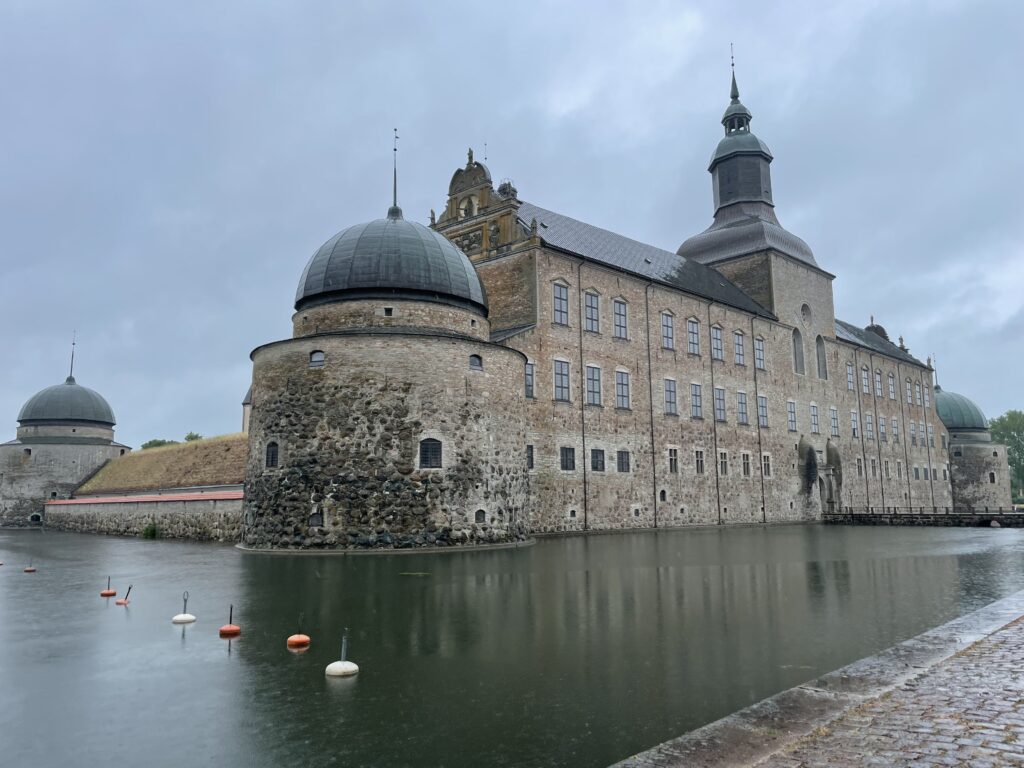
Vadstena’s moat-fringed castle under damp skies. * Photo: Peter Knego
The trolley delivered us to the Abbey, where an organist played and a hymnal singer crooned while our guide described some of its historic artifacts.
We then rode the train back to the castle, where we toured some of its bleakly grand halls. In one of the rooms, a radiant Small Tortoiseshell butterfly flitted in the gray light of one of its towering windows, probably having just been stirred out of hibernation.

Small Tortoiseshell beauty stirred. * Photo: Peter Knego

Of castles and classic ships! * Photo: Peter Knego
By noon, Diana was back on Lake Vattern, taking its modest swells, as well as the wind and pelting rain, with stride.
As we crossed, we enjoyed a special treat for lunch — authentic Swedish waffles with berry preserves and whipped cream.
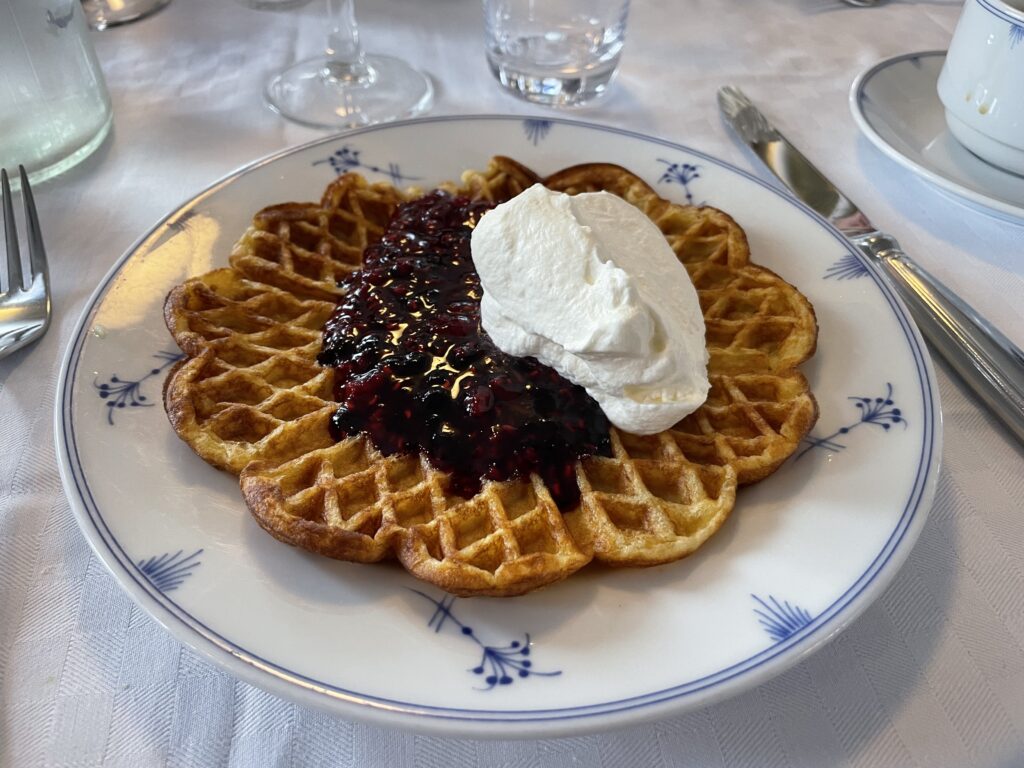
Waffles, Swedish style. * Photo: Peter Knego
At Forsvik, in a longstanding tradition, we were met with a canal-side gospel reading, Christian songs and a bouquet of flowers by the Kindbolm family, who have been greeting the canal boats for three generations.
During the rain-soaked exchange, our hostess Amanda presented them with a freshly baked apple cake.
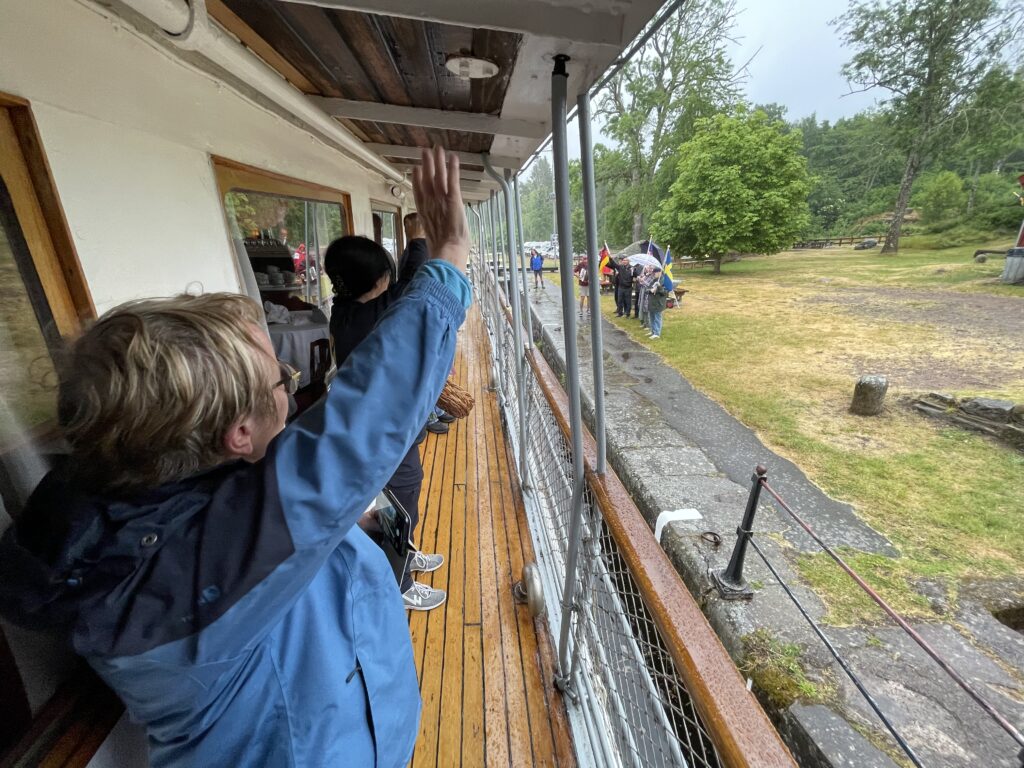
After exchanging greetings and a cake with members of the Kindbolm family at Forsvik, Diana continues on her journey. * Photo: Peter Knego
Since the diagonal rain and gusts of wind continued, the afternoon tea was held in the shelter of the dining room.
Soon, we were crossing Lake Viken, which is at the highest point in the journey and supplies water for the western portion of the canal.

Rainy day on Lake Viken. * Photo: Peter Knego
At 9:30 PM, after sailing through more beautiful but soggy scenery, Diana tied up at the town of Hajstorp for the night.
Day Five: From Hajstorp To Vanersborg on an MS Diana Cruise on the Gota Canal
With sunrise at this time of year around 3;30 AM and our cabin being a bit steamy while the ship lay motionless, we were wide awake as Diana sailed off on the final full day of our cruise, past more farmland and now actually riding down in elevation through the locks ahead.

Diana’s 92-year-old stem in its fresh water element. * Photo: Peter Knego
Another major highlight was passing her fleetmate Juno, which is the oldest overnight passenger ship in the world.
Built in 1874, she is a floating legend — for more info on Juno, click here for Heidi Sarna’s richly detailed feature about an eastbound sailing a few years ago.
Currently, Juno is operating three-night voyages between Goteborg and Stockholm, similar to the Diana’s but minus a few of the overnight stays.
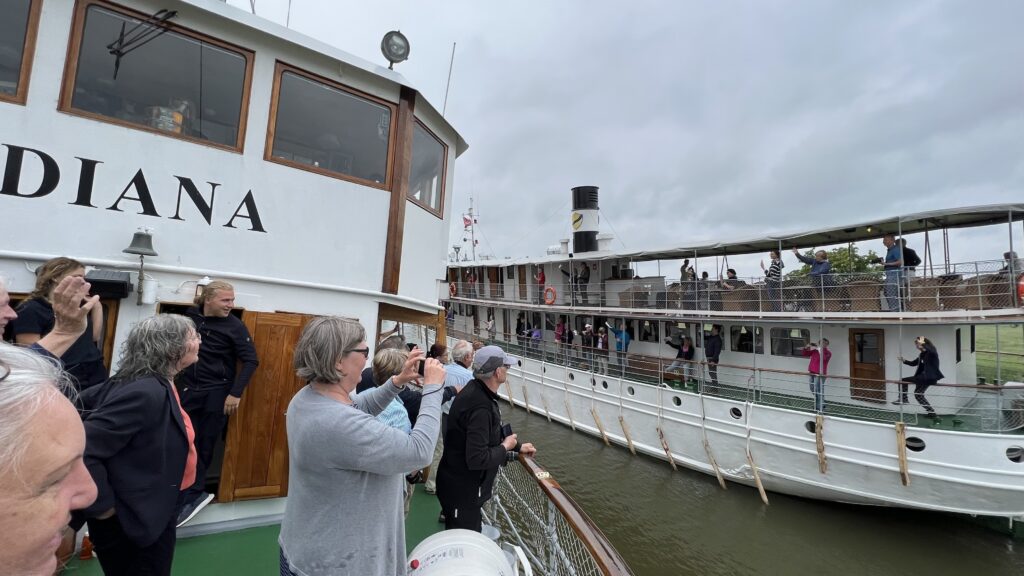
From newest to eldest in Gota tradition as Diana, goddess of the moon and hunt meets Juno, queen of the gods. * Photo: Peter Knego
With passengers lining the port rails of each boat, Juno and Diana listed towards each other as they sailed past in a grand salute. Another encounter for the history books.
In Sjotorp, we were able to disembark and follow Diana along the canal once again, this time through eight locks.

The Canal Museum at Sjotorp. * Photo: Peter Knego
The Sjotorp Canal museum is located there and has the bridge of a former canal boat, the Valborg II, among its displays, photos and model collection, which were free to visit for Diana’s guests.
After that, we were crossing Lake Vanern, the largest in Sweden and third largest in all of Europe.
I might add that my lunch during that smooth crossing was particularly good, with a simply mouthwatering vegetable cutlet alternative to what I am told were equally delicious Swedish meatballs.

My excellent vegetarian alternative to the authentic Swedish meatball lunch course. * Photo: Peter Knego

Meatballs, Swedish style. * Photo: Peter Knego
And it was as discreet as it was tasty, too, so fellow veggies need not worry about a big fuss being made over their dietary preferences on an MS Diana cruise on the Gota Canal.
At 3:30 PM, we were pulling up to a landing at the base of the picturesque Lacko Castle, which looks like something out of “Sleeping Beauty.”

Fairytale, picture post card view of Diana in front of Lacko Castle. * Photo: Peter Knego
Our included tour by local guide Frederik was fantastic, explaining much of the castle’s backstory and laced with that dry Swedish humor I had come to enjoy so much.
Unlike the prior castle, Lacko was brimming with strikingly original frescoes, paintings and lavish furnishings that really brought its history to life.
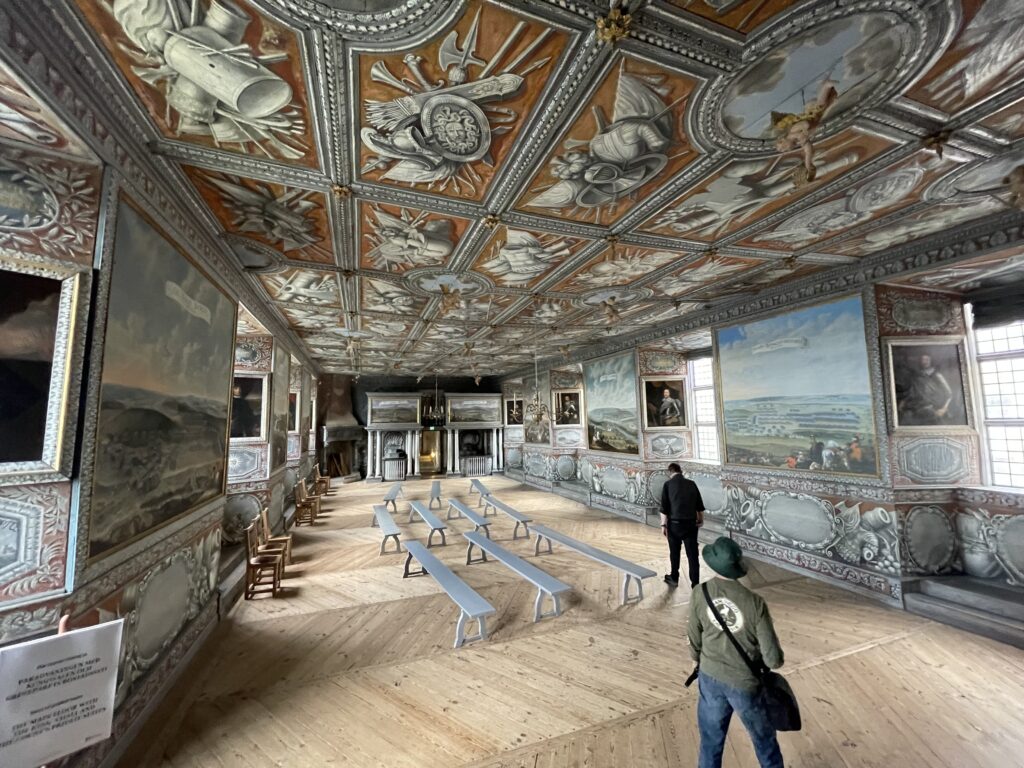
Entering one of the grand halls of the Lacko Castle. * Photo: Peter Knego
There was also an exhibit about Animals In Art, which was on loan from the Swedish National Museum.
After our tour, we had enough time to zip back to Diana and don our running gear for a three-mile romp through the local scenery, returning moments before she cast her lines and sailed onward to Vanersborg, where she overnighted.
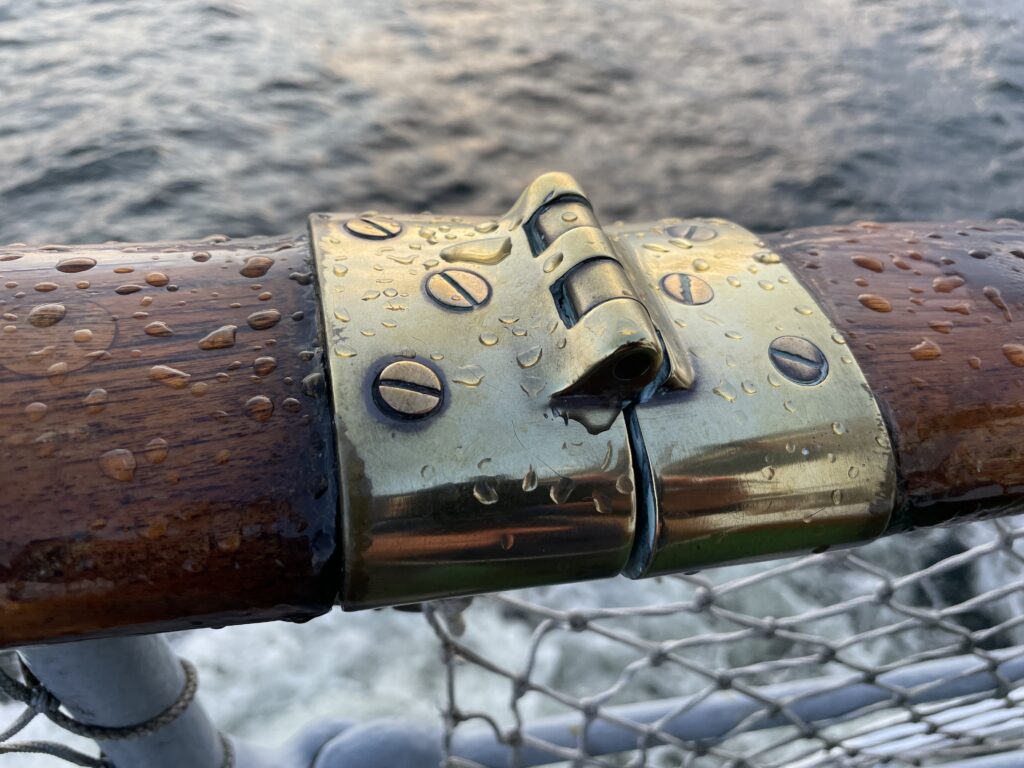
Back on Lake Vanern aboard Diana, where rain meets polished brass. * Photo: Peter Knego
Meanwhile, it was the captain’s farewell evening on board. A nice touch was that each setting was graced with a local Swedish flower and bubbly was provided during a series of toasts as captain and crew thanked us for joining them on the voyage.
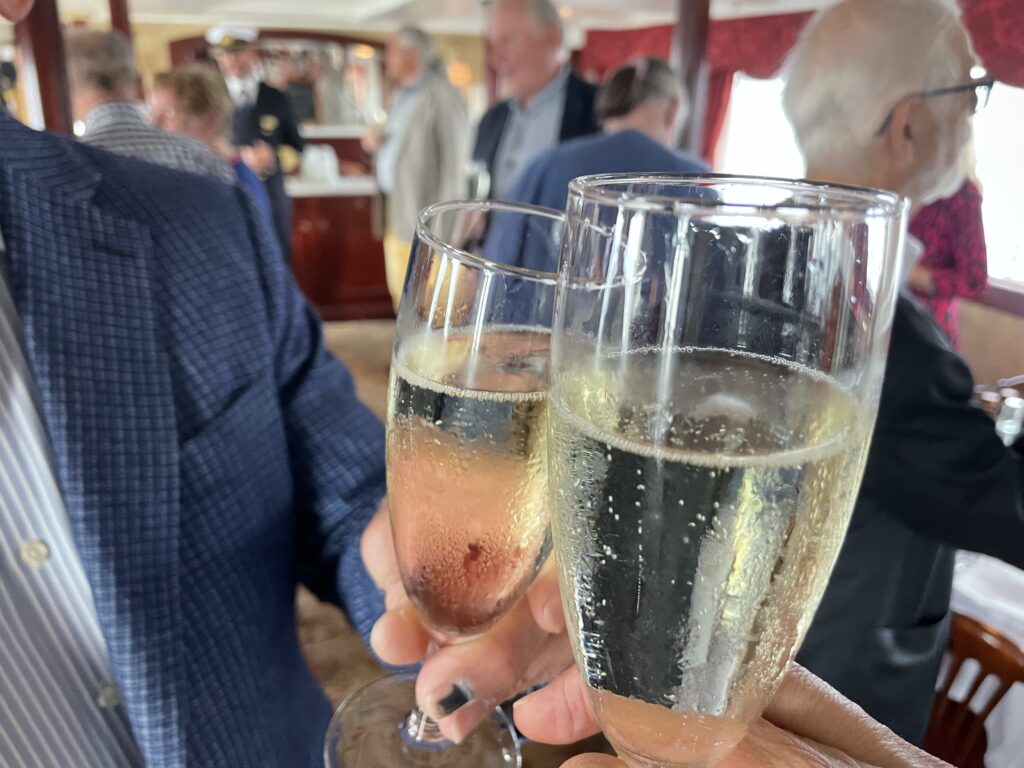
Chilled bubbly for the captain’s farewell toast. * Photo: Peter Knego
After dinner, we were offered a visit to the galley, a surprisingly tiny space where all the week’s culinary magic transpired. The galley is actually on Main Deck, directly below the Dining Room and services the Dining Room via a hand cranked dumbwaiter than can safely transport up to 12 covered plates at a time.
With just the two chefs and two waiters, it is actually a feat of engineering to get everyone on board served in a timely fashion and yet they do it seamlessly, twice a day.
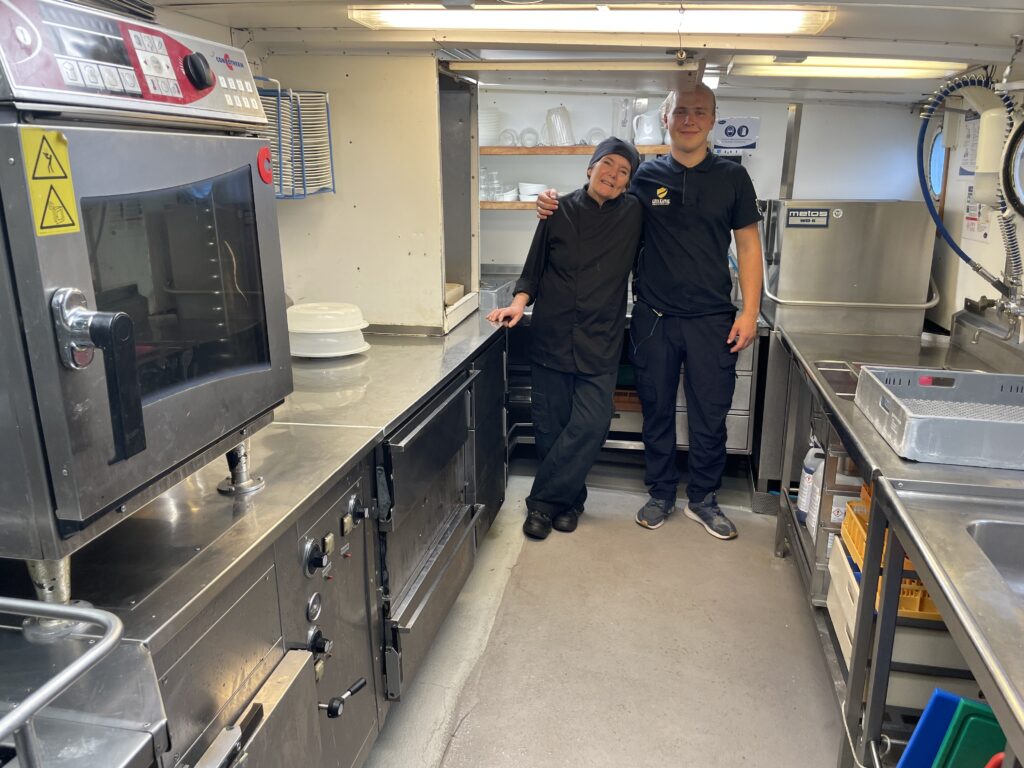
Tiny galley with Chef Eva and cheerful, multitasking deck hand Jacob, who climbed all sorts of ladders, undid and secured the lines, kept the ship clean and polished, dried the dishes and always made guests feel welcome. * Photo: Peter Knego
Day Six: The MS Diana Cruises From Vanersborg To Goteborg (Gothenburg)
At 7:30 AM on the final day, we passed the Brinkebergskulle Lock, which is the oldest in the system and dates from 1752.
An hour or so later, we had arrived at Trollhattan, which has a staircase of four locks that would eventually lower us nearly 105 feet.
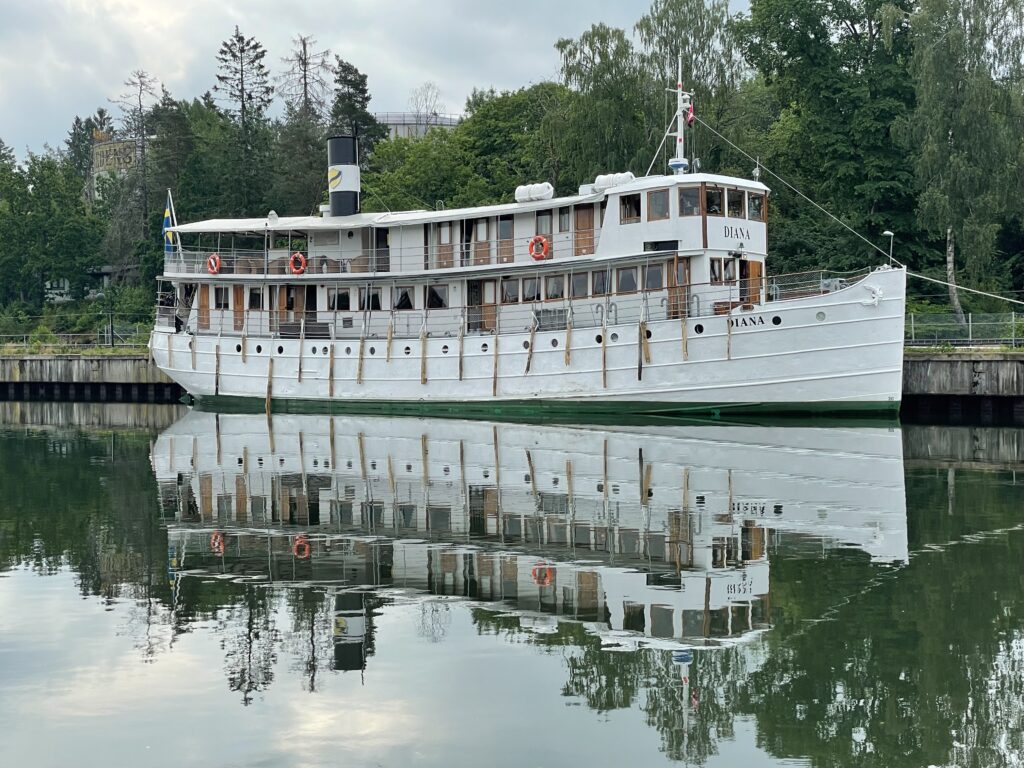
Reflections of Diana at Trollhattan. * Photo: Peter Knego
There was some free time here, our last to enjoy ashore before the end of this splendid journey.
We paid a visit to the Trollhattan Canal Museum, where we watched a film on the canal and perused the exhibits, which to my surprise included a large model of Swedish American Lines Gripsholm, a gorgeous luxury liner that was built in 1957 and last served for now defunct Regency Cruise Lines as the Regent Sea.
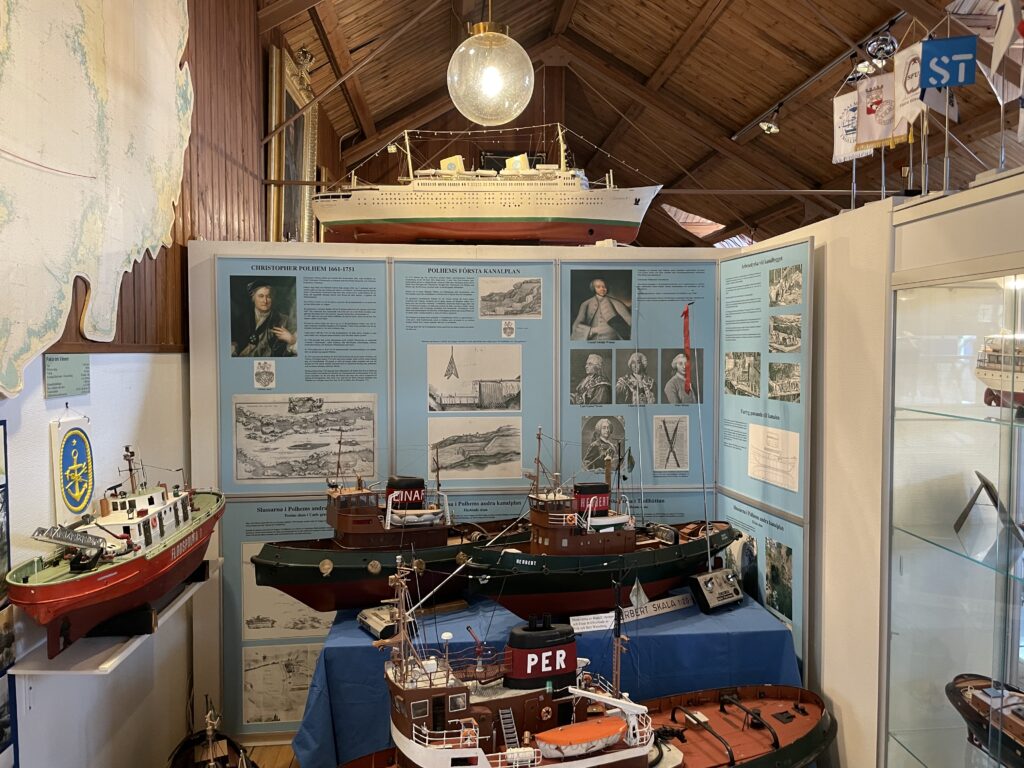
A strangely proportioned model of the 1957-built transatlantic liner and deluxe cruise ship Gripsholm towers over the exhibits in the Trollhattan Canal Museum. * Photo: Peter Knego
Another nice bonus was the handsome, preserved excursion boat, the Elfkungen, which dates from 1875 and is used on short cruises in the region.
At 12:25, we were passing through the last lock at Lilla Edet, which would put us at North Sea level for the rest of our journey to Gothenburg.
Another nice highlight was being granted a visit to the engine room, which is spotless and features those 2009-built diesels that so reliably propelled Diana along her time honored route.
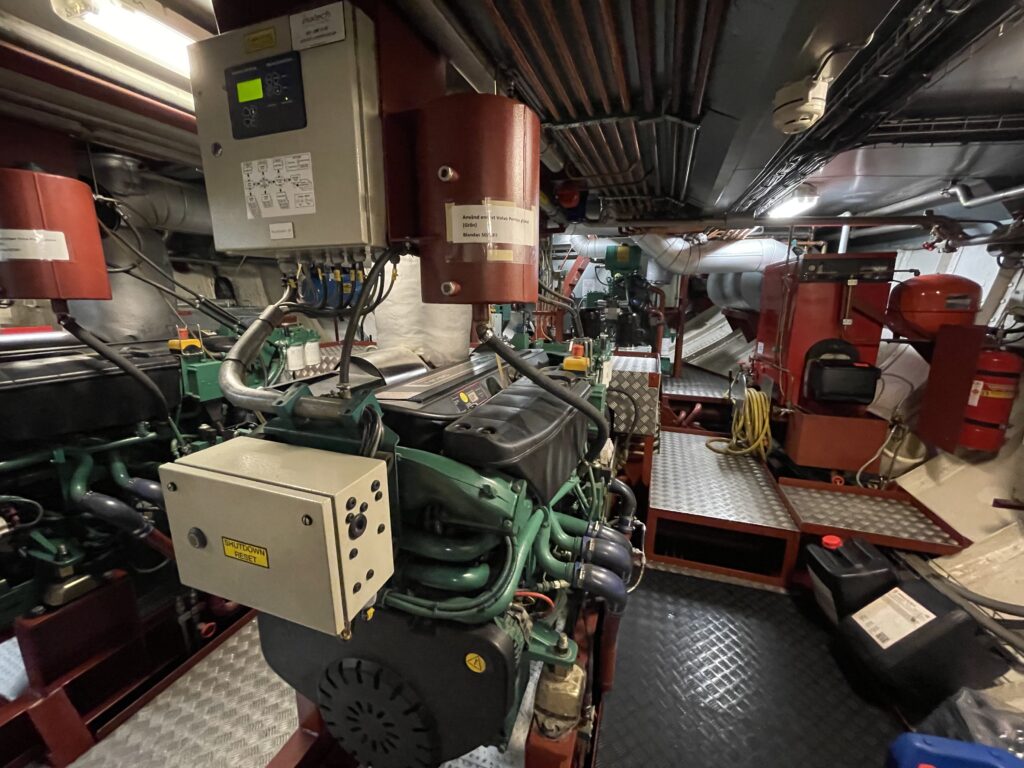
The Diana’s spotless diesels can propel her at a top speed of ten knots. * Photo: Peter Knego
After packing and one final lunch as the outer limits of Goteborg wafted by, we watched from the Bridge Deck as the crew lined up our luggage in the lounge, preparing it for offloading when Diana reached her berth alongside Goteborg’s old custom’s house.
The timing was ideal as I was down to the last few pages of “Roseanna.”
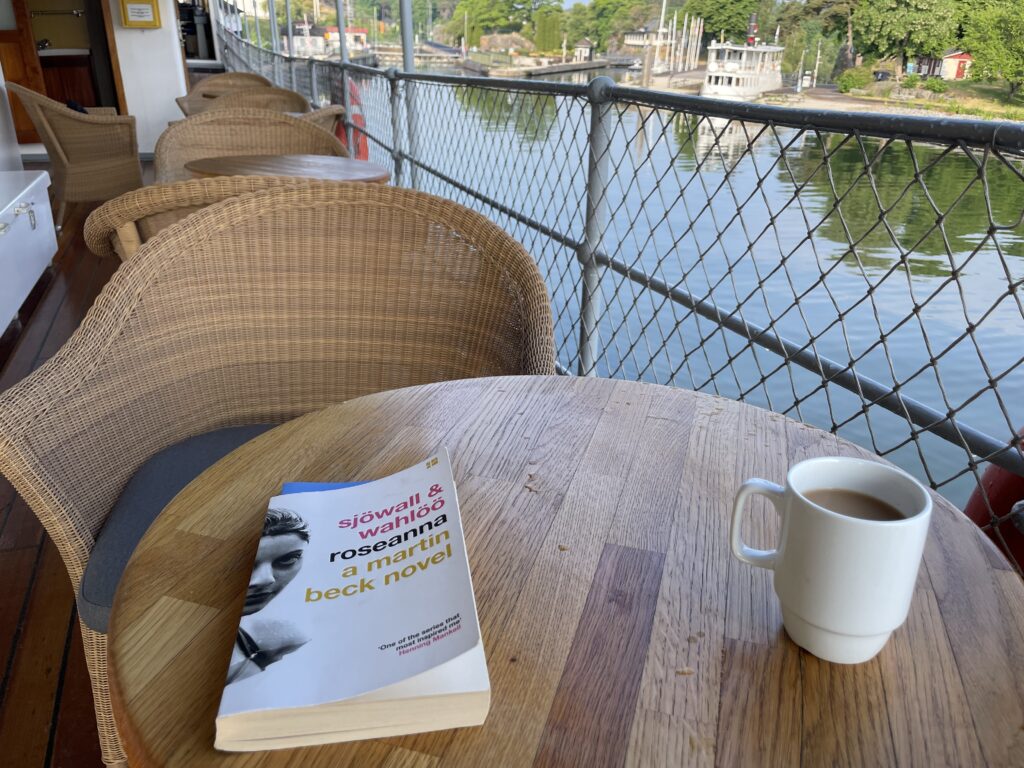
All too soon, just as I closed my book, the crew lined up on the quay to send us off with a warm farewell.
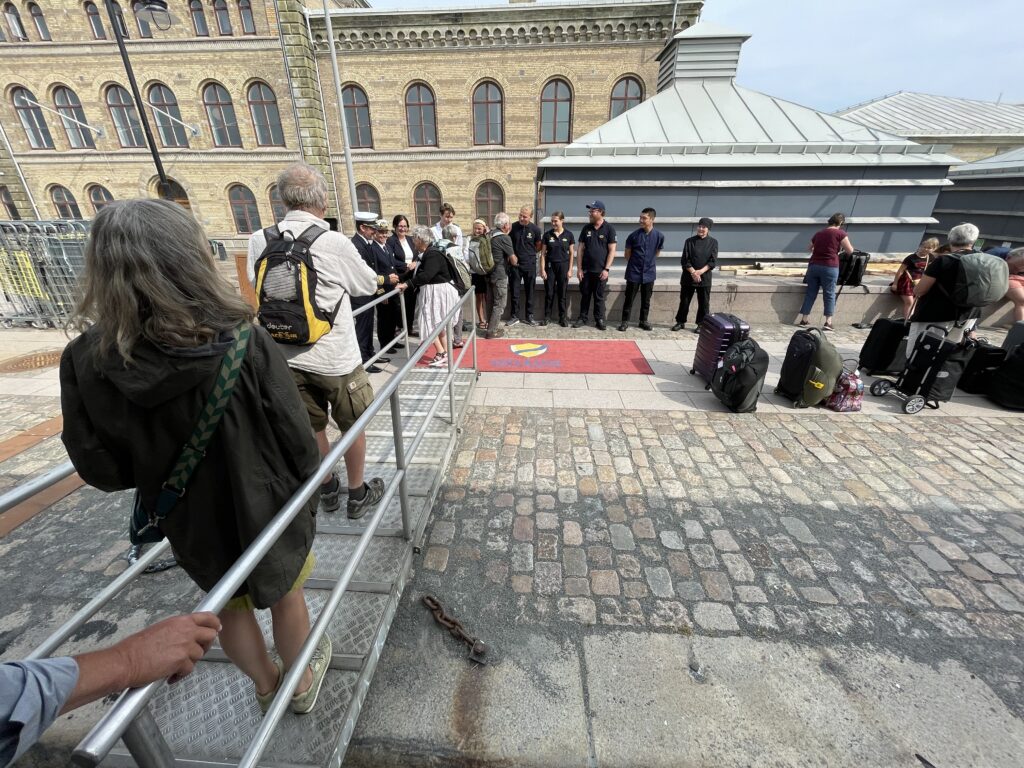
Con te partiro, Swedish style. The lovely staff and crew of Diana line up on the quay at Gothenburg to say goodbye. * Photo: Peter Knego
We then wheeled our luggage over more of those bumpy Swedish cobblestones to our hotel as Diana prepared to embark a new crew and a completely full complement of guests for the next day’s eastbound departure.
Well, since our hotel was just a block away, we couldn’t help but to “stalk” Diana the next morning as she sailed off on her easterly voyage at precisely 10:00 AM.
I certainly hope to see her and her gallant sisters again one day!
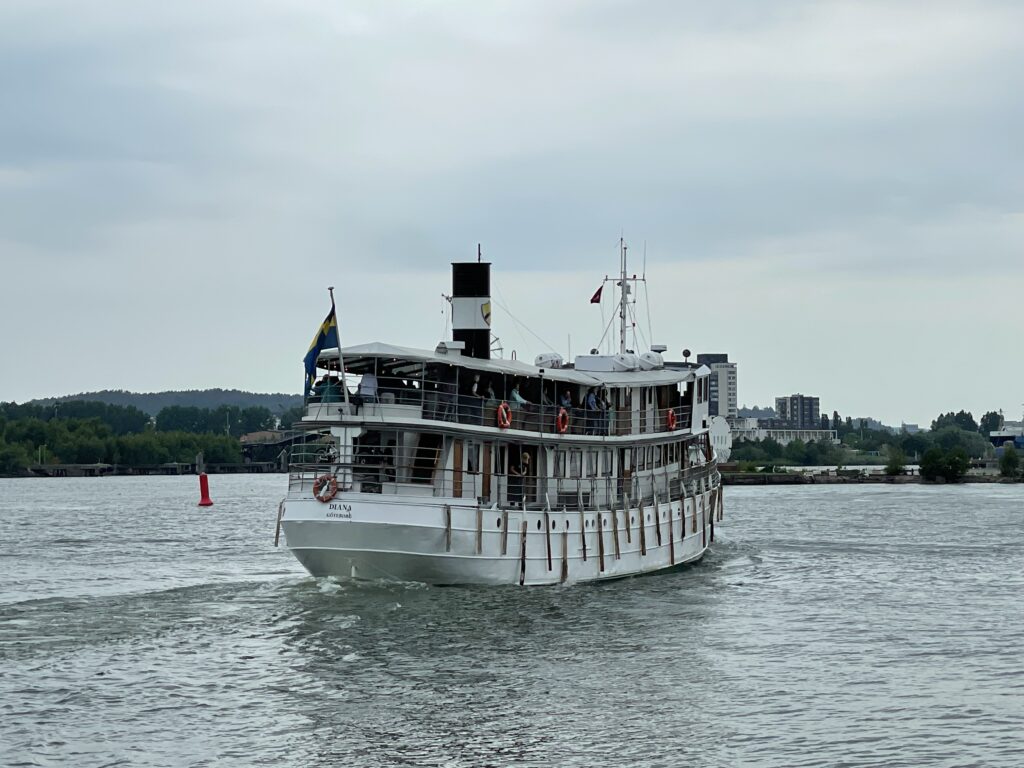
Diana departs on her next eastbound voyage. * Photo: Peter Knego
Interested in an MS Diana Cruise on the Gota Canal?
The five-night/six-day Grand Sweden Cruise on the Diana that Peter experienced starts at about $2,400 USD (SED 25,415 Swedish Kronor) per person for double occupancy accommodation (including meals and excursions).
For more information, visit the Gota Canal website.
Don’t miss a post about small-ship cruising, subscribe to QuirkyCruise.com for monthly updates & special offers!
© This article is protected by copyright, no part may be reproduced by any process without written permission from the author. All Rights Reserved. QuirkyCruise.com.

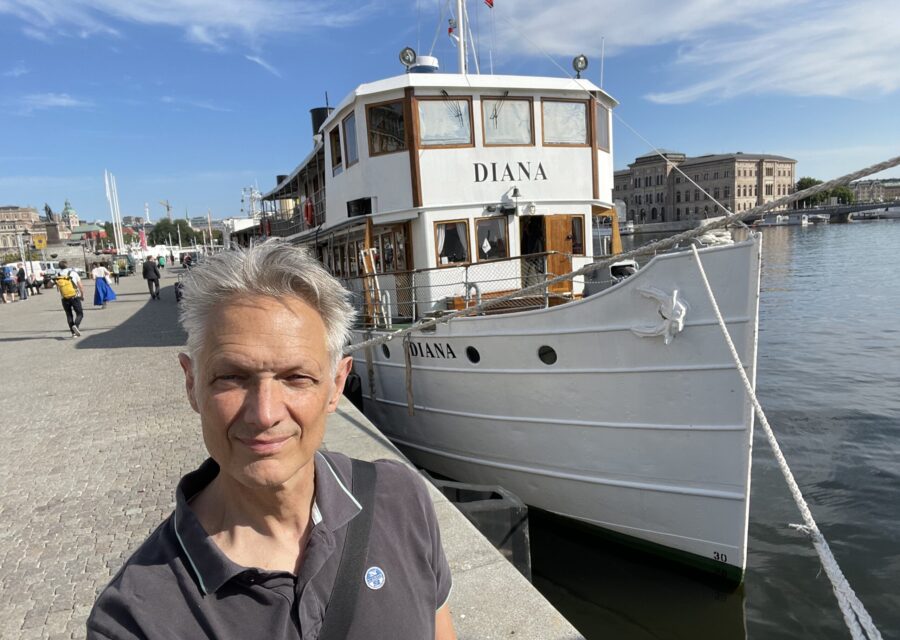
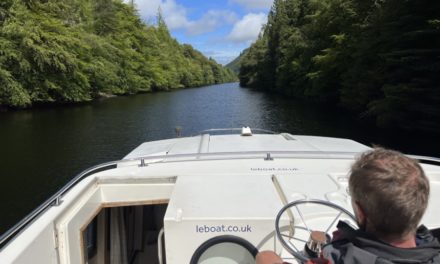

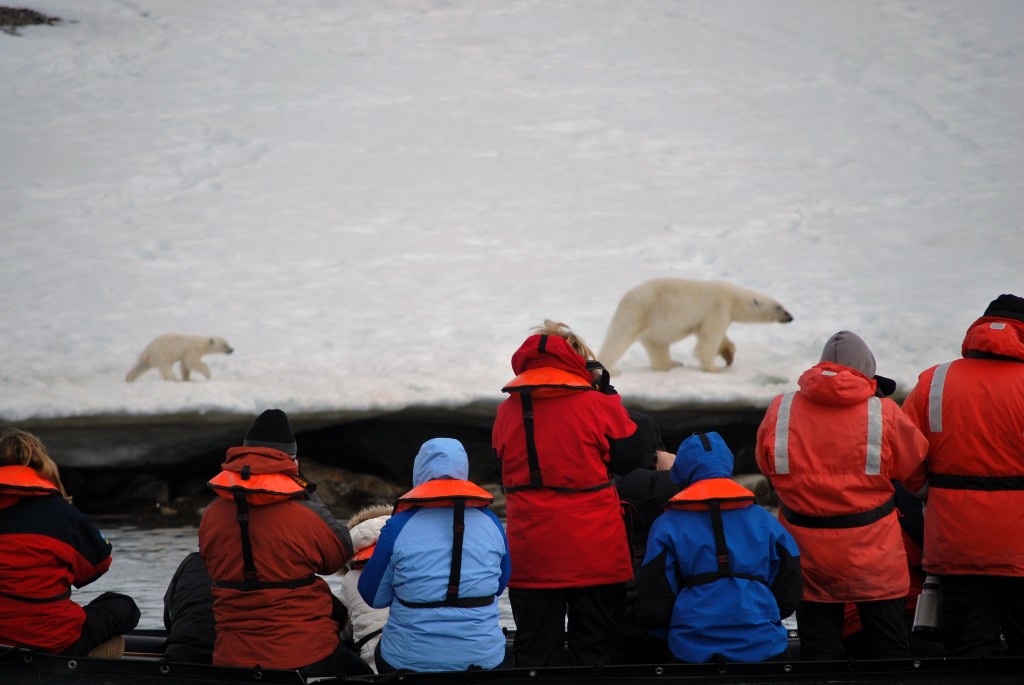
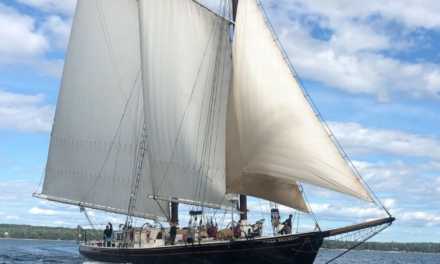








 HEIDI SARNA
HEIDI SARNA











